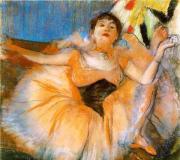A guide to reconstructing ancient Greek costume. Part III, tailoring a suit, guys. History of costume in ancient Greece.
Many people associate Ancient Greece with heroes ancient greek myths: brave Jason, mighty Hercules, sweet-voiced Orpheus..., as well as with the ancient Greek gods: Zeus the Thunderer, the gods of war Athena and Ares, the gods of beauty Aphrodite and Apollo, the goddess of hunting Artemis, etc. Heritage ancient Greece still fascinates us to this day. Skillful temple builders, sculptors, scientists... but, above all, the ancient Greeks were people who, despite the cult of a perfect body, still wore clothes. This is exactly what we will talk about in our article.
*"...The ancient peoples who lived on the islands in the Aegean Sea basin and on the Mediterranean coast, where the state of Ancient Greece subsequently arose, created a most interesting and original culture, little studied by contemporaries and in many ways still not understood - this is the Cretan-Mycenaean culture This culture originated among the islands of the Aegean Sea. ancient culture there was the island of Crete, which had excellent natural conditions. On the Balkan Peninsula, the largest and most significant state was Mycenae. Both of these cultures are closely related and had much in common. The Cretan-Mycenaean culture was the foundation ancient Greek culture. But in vain we will look for signs of Cretan-Mycenaean culture in the forms of Greek clothing. The conditions in which ancient Greek culture was born, developed and improved were different, therefore the clothes of the ancient Greeks were different. Only the loincloths of men, preserved in the clothing of the early archaic period of the development of Greek culture, remind of the origins of the Greek costume culture...
Characteristic feature ancient Greek clothing was the art of draping clothing. The ancient Greeks created the perfect type of draped costume from individual, mostly rectangular pieces of fabric. Artistic sense This costume was to use the plastic properties of the fabric to create a complex linear rhythm of draperies, which gave majestic dynamics to the entire appearance of a person. Constantly changing in movement, this costume consisted of many loosely lying draperies, intersecting in different directions, appearing in one place or another, which, despite its simplicity, did not create the impression of monotony. Each suit was individual, although it was always made from pieces of fabric of the same shape and often even the same size.
This suit had two options:
- Dorian(hlena, peplos), which was common among the inhabitants of mainland Greece. The appearance of this type of clothing is associated with the conquest of a significant part of Hellas in the 9th century. BC e. Dorians;
- Ionian(chiton), which was common among the Greeks of Asia Minor.
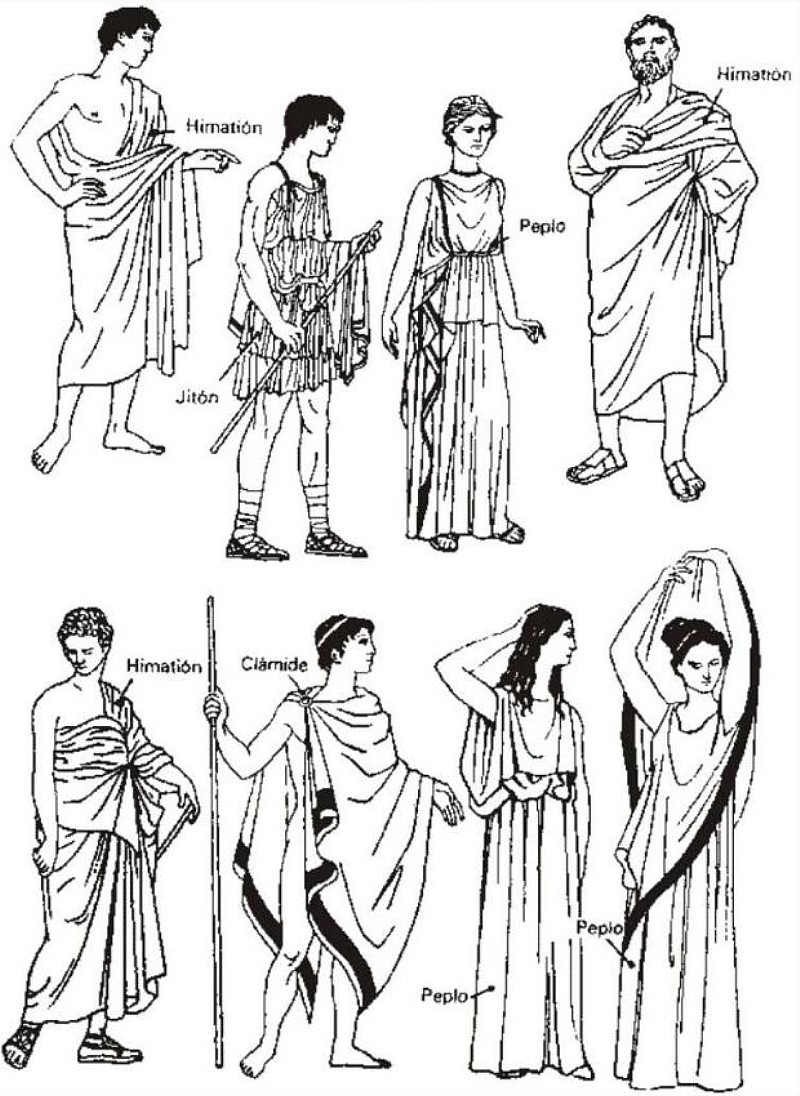
General characteristics of the suit
The history of ancient Greek ancient society begins in the 11th century. BC e. since the migration of the Dorian tribe to Greece. From 11th to 8th century. BC e. the collapse of the primitive communal system of the Greek tribes occurred, arose private property, family aristocracy. Slave-owning relations gradually developed. This period is called Homeric (archaic) because it is glorified in Homer’s immortal poetic works “Hellas” and “Odysseus,” which depict the living conditions of the Dorian Greeks.
7th - 6th centuries BC e. are considered in the history of art of Ancient Greece to be the period of early and mature classics, the “golden age”, the heyday of slave-owning democracy.
5th - 4th centuries BC. - this is the heyday ancient art, which is often called the Age of Pericles.
After the restoration of Macedonian hegemony over Greece (3rd century BC) and the military campaigns of A. the Great, the first signs of the decline of ancient Greek ancient culture. The spread of ancient culture to the east and west was simultaneously accompanied by its collapse under the influence of the culture of the conquered states. In the 1st century BC. Greece lost its political independence and became a Roman province, and with the conquest of the main part of the Hellenic east by Rome, the independent history of ancient Greek ancient culture ends. This period is called the Hellenic period. Chronologically it dates back to the end of the 4th century. BC e. and until the end of the 1st century. BC.
Ancient Greek city-states were slave society. Broad layers of free citizens, called demos, had access to the management of policies. Therefore, this regime was called slave-owning democracy. An example of such a policy was Athens (5th century BC). The special system of slave-owning democracy created the conditions for the powerful development of ancient culture, which later had big influence for the whole future culture humanity. It is in this social order Scientific knowledge of the world has developed with the help of philosophical sciences and a life-affirming optimistic worldview was formed, which was based on the ideas of human physical and spiritual culture, freedom and civic valor.
Ancient Greek costume developed in close dependence on these features of the social system. Its main national characteristics Ancient Greek costume was invariably preserved until the Hellenic period. After this, he began to gradually change due to the influence oriental cultures and culture Ancient Rome. At the beginning of our era the ancient Greek costume lost its originality and merged with the Roman costume. The idea of the human body as a harmony of beauty in nature, a deep understanding of its plastic forms and highly developed Physical Culture bodies, determined anciently Greek style, which consists in the harmony of fabric and shapes of the human body, emphasized naturalness and proportionality of the figure.
![]()
The first ancient Greek costume was a wrapping and draping garment. This type of clothing acquired shape only after it was draped on the human figure. Clothes were fastened different ways. First, without the help of a needle and thread, but with various hairpins, knots, plaques, brooches. Rectangular pieces of fabric draped freely, creating a roomy, loose-fitting garment that did not interfere with movement. The belt was often worn to support clothing, for a softer drapery of folds, rather than to tighten the figure. Even a kind of bandage made from the thinnest leather - station(wide breastband) was a way for Greek women to emphasize their figure. All the beauty of the ancient Greek costume lay in the freely and softly falling sculptural folds, which emphasized general outlines body, while hiding its flaws.
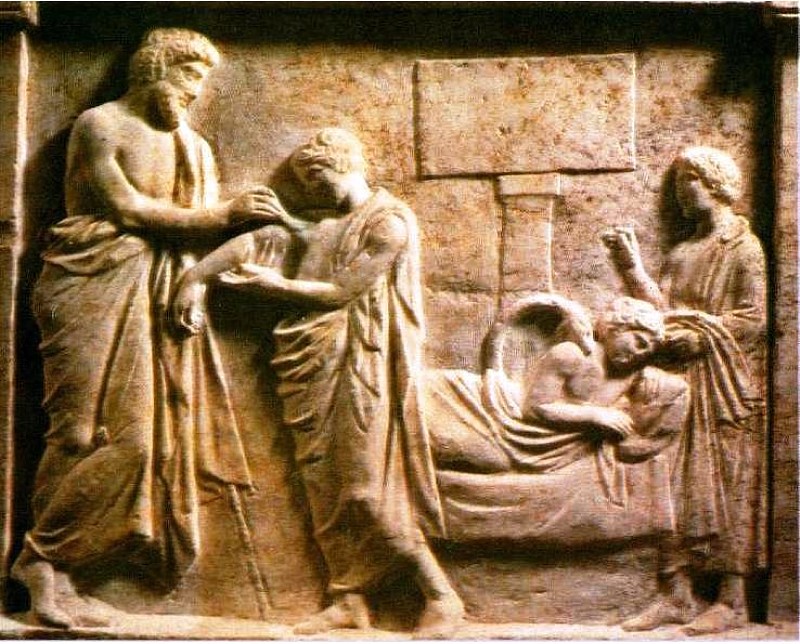
In antique costume main role played the cult of beauty and harmony of the body. Therefore, his nudity did not evoke feelings of shame and indecency. The costume itself had no special meaning, but was only an addition to the naked body. Without violating the standards of decency, the ancient Greek costume could expose arms, shoulders, legs, and even thighs.
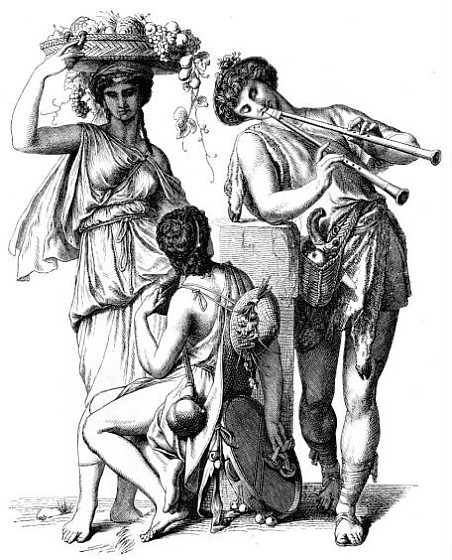
Male and female ancient Greek costumes were basically identical. Even the methods of draping differed little. Social differences in the costume of antiquity were also of little significance.
Characteristic features of men's and women's clothing
The main element of the ancient “pre-Homer” clothing of the Greeks during the archaic period is a quadrangular woolen scarf, which the Dorians tribe that came from the north brought with them to Hellas. It was the same for both men and women, but how men's clothing it had a name horseradish , but as women's - peplos (2x1.8 m). It was wrapped around the body and secured at the shoulders with hairpins. This was the so-called Dorian clothing, created according to a completely original principle without cutting and sewing. Under the khlena, men wore a narrow apron tied around their hips. This is an element of clothing borrowed from the Cretan-Mycenaean culture. Later, in place of this apron, first at the easternmost Greek tribe- Ionians, - an element of clothing appeared, borrowed from the Semitic East - chiton . A chiton is a shirt-skirt, sewn throughout and decorated with skillfully laid folds. This tubular linen clothing during the archaic period became the dominant form of clothing for almost all classes in Ancient Greece.
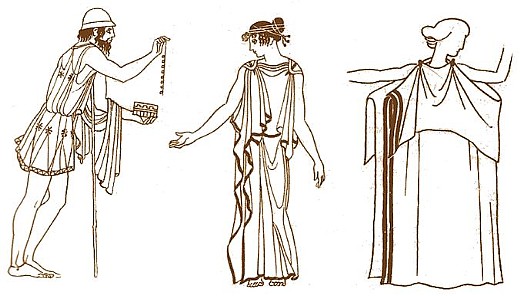
Ionian clothing, which partially replaced the ancient Dorian, according to Herodotus, was introduced in Athens during the reign of Peisistratus (560 - 527 BC). The Ionian chiton was the first closed garment that the Greeks could wear without pins. A short chiton served casual clothes, long - mainly festive attire of elderly and noble people. A chiton with a train was a property of the island Greeks.
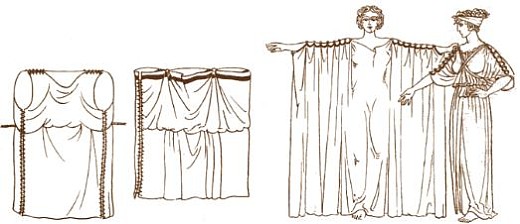
Women's wardrobe was much richer than the man's. In addition to the embroidered linen chiton, a number of new forms of clothing appeared, for example, tailored and sewn outerwear with sleeves, similar in shape to modern blouses and jackets. For it, they used not only pure white linen, but also linen decorated with trim, as well as luxurious fabrics imported from the East.
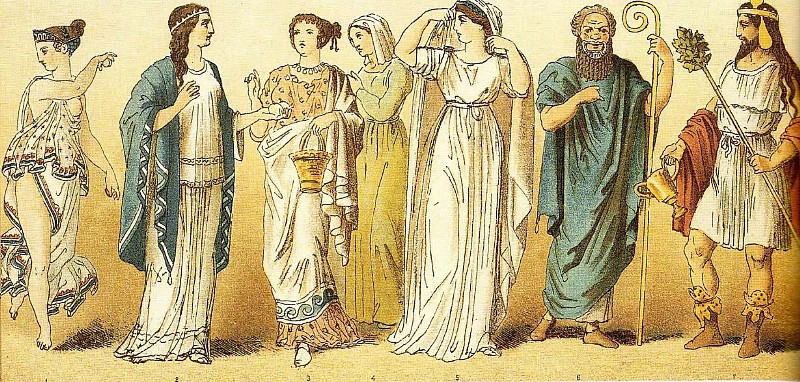
After the Greco-Persian warriors, the Ionian outfit was pushed into the background. The reform began with Sparta and more or less covered the whole of Attica. IN classical period Simplicity and restraint in clothing was considered good form. The fusion of Dorian with Ionian style led to the emergence new classic style Greek clothes . Only this clothing, completely independent of the dictatorship of fashion, with large wavy lines of heavy draperies, or easily floating, or with moving soft folds, always appropriate to the circumstances, allowed the body breathing under it to live own life.
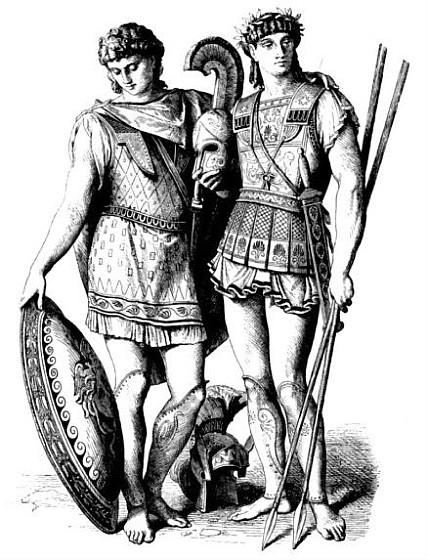
Initially, the khlena of men and the peplos of women were wrapped so skillfully around the body that they were not sewn together anywhere, but were pinned only with a pin on the shoulder. However, this ancient form of Dorian peplas, preserved in Sparta, was soon modified: the side edges on the right were sewn from the hip to the bottom, so that a kind of skirt arose that was belted at the waist. A chiton is a shirt with seams on the shoulders, which was initially worn by both men and women. Men did not girdle their tunic, but wore it together with a cape covering the left shoulder, called himation . Its dimensions reached 2.9 x 1.8 m. A woman’s tunic could not be sewn, but secured with clasps on the shoulders. It was belted at the waist or under the chest, in such a way that a fold of fabric hung over the belt - kolpos (Greek - womb, womb, sinus), which sometimes took the form of a separate cape. Along with it they also wore a real cape - diploidium or diplos , which was passed under the left arm and brought out to the right shoulder, where it was fastened with a clasp ( fibula ).
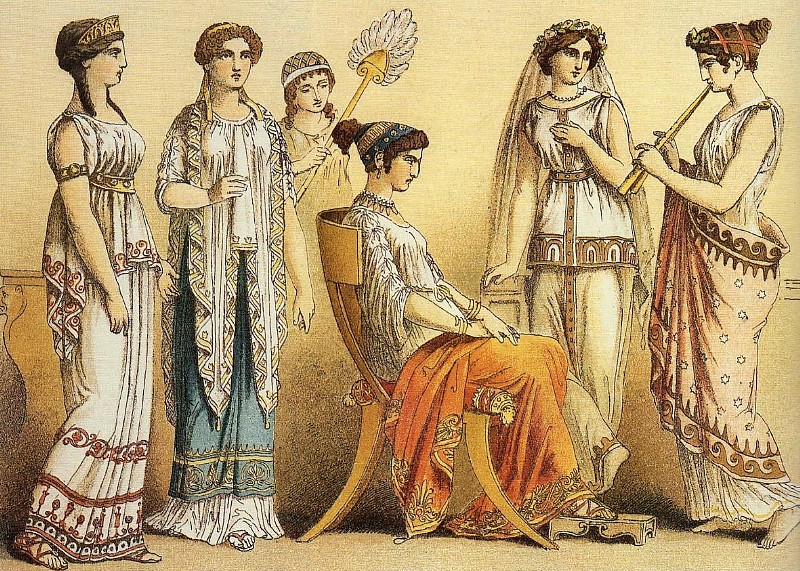
In contrast to the spacious himation - the clothing of women and adult men, young warriors wore a short cloak-like cape, which was called chlamys . The chlamys is a light short cloak for riding, also rectangular in shape with a colored border and tassels at the lower ends. It was placed on the left shoulder, and the upper ends were connected on the right with a clasp - agraph . Chlamys comes from Thessaly. Along with this little raincoat for riding and traveling for the most part wore a felt traveling hat - petas .
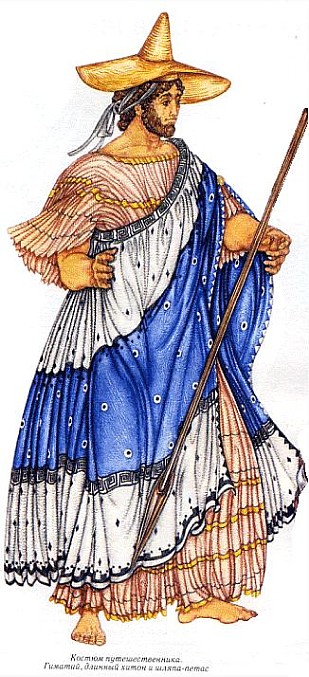
Women's hats I almost didn’t know Greek costume. That's why great importance was given an elaborate hairstyle. In addition to the himation, women covered their heads with a very short veil - credemon , which reached the eyes, and from behind fell freely onto the back of the head and back.

![]()
The clothing of slaves was the same in cut and shape as that of free Greeks, as was the clothing of the ruling classes. It differed only in that it was made from coarse wool of natural color - brown, brown and grayish shades.
Craftsmen, slaves, peasants wore more simple clothes - exomis (2.3 x 1.4 m) is a piece of coarse fabric, which was folded in the middle and covered the left shoulder. To prevent the fabric from drooping down the arm, it was supported on the right side by a special bandage. At the waist, the exomis was strengthened with a belt.
Fabrics and their design
The main fabric for clothing was wool, which was used for outer and underwear. The Greeks could produce coarse and fine fabrics from wool. Along with wool, linen fabrics were used. IN early period development of ancient Greek culture, especially in the Ionian city-states, women's clothing made from translucent fabrics, so-called veils. In the Hellenic period, they were very common with the exception of Sparta, which preserved the simplicity of life and costume for the longest time.
Clothes were also made from fabrics made from mixed fibers of wool and flax. The fabrics were woven on vertical looms. The parallelism of the warp threads was achieved with the help of weights that were tied to the warp threads. The fabrics were loose, somewhat reminiscent of modern crepe. Such fabrics draped easily. The Greeks liked to decorate draperies with pleating or creping.
Silk and cotton were brought to Greece from the east only at the end of the Hellenic period. These are the so-called bamboo silk translucent fabrics. Bamboo fabrics- fabrics made from wild silkworm silk.
So, in view of the upcoming festivals and the influx of people interested, we continue to create a manual for “children”)
The first two parts, regarding fabric and color, can be found in this blog, but now let’s take a quick look at the men’s suit. In this part we will not delve into various ancient Greek subtleties, the variety of names, the evolution of costume, etc. Let's focus on the application part and simplicity: so that even a fool can understand what, how and from what to make. Taking into account the experience of the previous story, we simplify, exaggerate and shorten even more, because otherwise people do not understand.
Starting the main part of the report, I would like to draw the reader’s attention to the fact that the very logic of ancient Greek clothing was very different from modern: the Greeks cut clothes to the minimum, almost all Greek clothing consists, roughly speaking, of in a certain way rectangles tied, hemmed or pinned to the body. To achieve decorative effects, drapery and fabric finishing were used. In this regard, the choice of fabric must be approached very carefully.
Chiton.
This is sleeveless underwear, which, for some reason, we often like to incorrectly call “tunic.” The tunic could be worn without any other clothing, but more often with a cloak (himatium, chlamys).
Chiton in literature is often divided into two types (in addition to a bunch of others): Dorian and Ionian (the name comes from Dorians and Ionians, respectively). A “simple” short chiton is considered Dorian, and a long one is considered Ionian. Sometimes you can find the definition of Dorian as wool, and Ionian as linen. If you look at the nuances, then confusion ensues. We won’t get into this casuistry here, we just remember that such a division exists, but how it was in men's suit in reality, no one really seems to know. Most likely, the Ionian chiton was, indeed, longer and wider (which determined the choice of thinner fabric), and the Dorian chiton was simple, short “for men.” In reality, where one type ends and another begins is difficult to say, since chitons were quite diverse, and it is difficult to detect any clear boundaries for the use of long/short/wide/woolen/linen chitons. Well, in Sparta, for example, a fluffy linen chiton is definitely not allowed.
Material: linen, wool.
The design of the chiton is extremely simple: it is a rectangular panel wrapped around the left side, sewn along the right side, or simply tied with a belt so that the edges on the right are on top of each other (remember that with the second option, an unpleasant embarrassment for a modern person may occur in the form of unintentional exposure sirloin). On the collarbones (in the picture below from the network - at points A and B), the chiton is either pinned into brooches or sewn together.
This design allows, if necessary, to completely release right hand, as also shown in the figure below (this was used, for example, by warriors and artisans; the latter even had a special kind a working chiton made of coarse fabric, sewn only on the left shoulder - exomis)
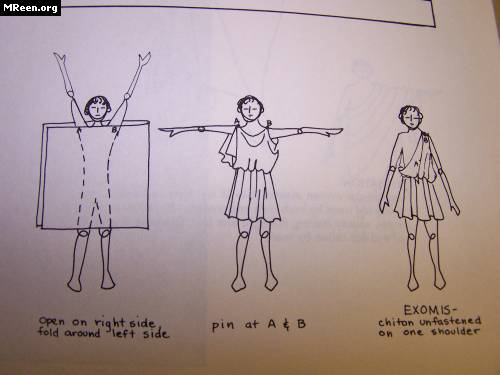
We measure the length of the fabric from the top of the collarbone to the middle of the knee (+ reserve for hemming). The width of the fabric for an average person will be approximately 2 meters (i.e., in its finished, “folded” form, the width of the tunic will be 1 m) or more. It should be noted that increasing the width will allow you to create more draperies, and in general it will look better, but it is unnecessary thick fabric may not fit into folds and bulge a little on the sides.
Here you can clearly see what size it is, and how the armholes of the linen chiton formed for the arms “behave” (here the total (! that is, two sides) width of the fabric is about 2.4 meters)
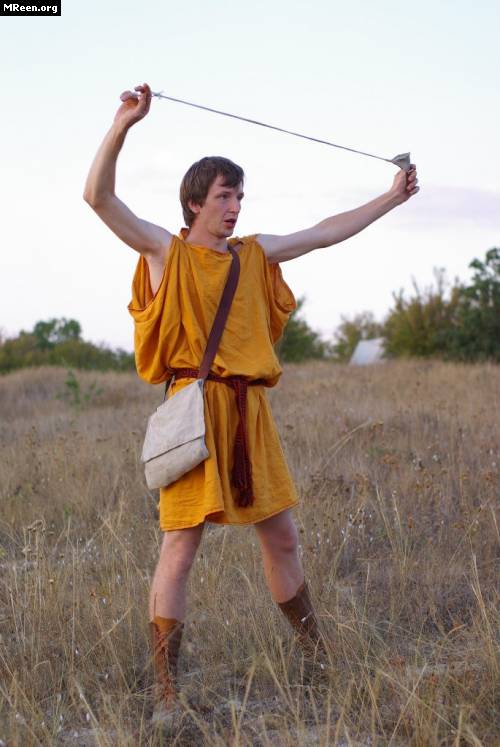
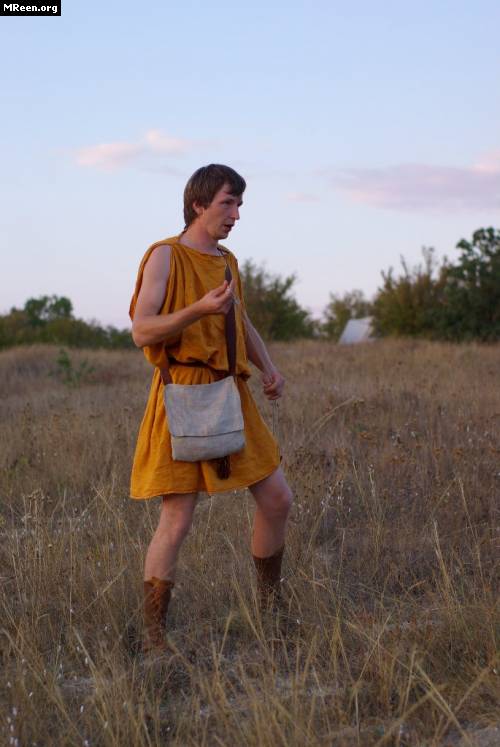
The bottom of the tunic must be hemmed (an unhemmed bottom is a sign of mourning, insanity or slavery).
The chiton could have been longer, right down to the feet. But it seems that its use was mainly associated with sacred rites, the performance of government duties, acting, or the venerable age of the wearer. In general, this is a very “decent” option.
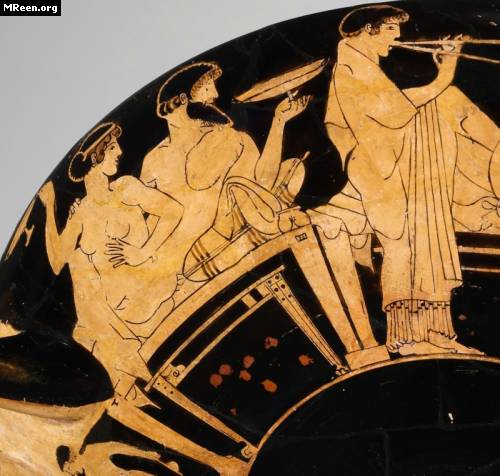
With such a pattern, especially if you sew the sides, the rule applies: the longer the chiton, the wider it should be. For convenience, it could be tied with a cord, as was done by the Delphic charioteer.
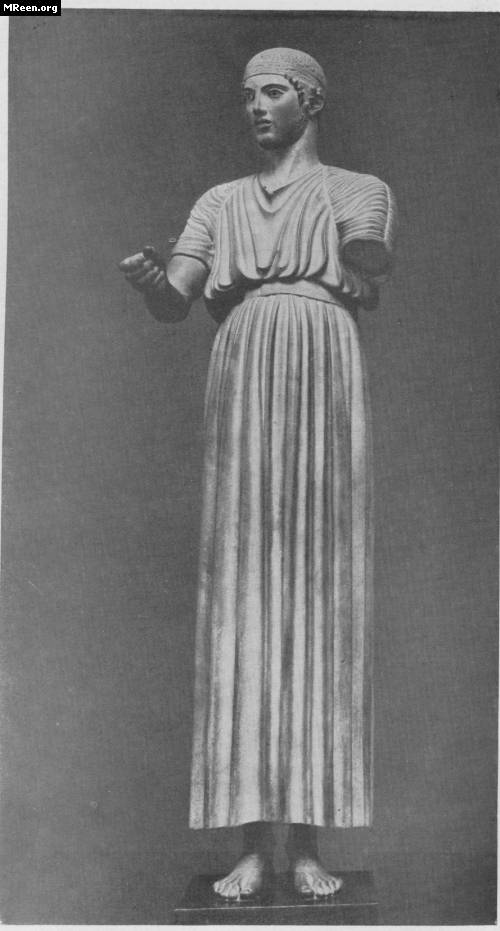
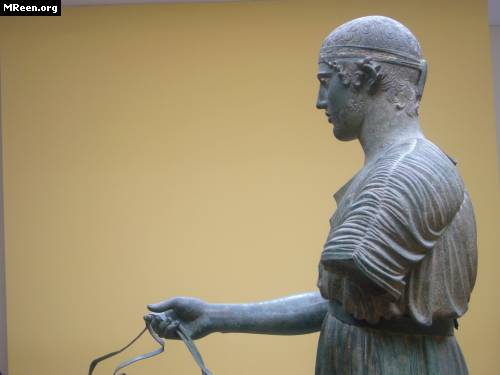
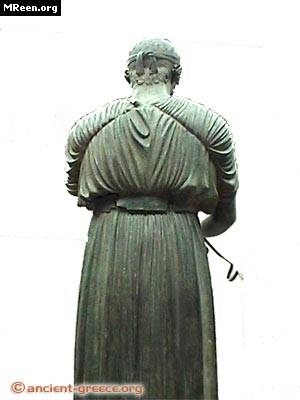
A shorter chiton could also be tied in this way. In this case, peculiar “sleeves” are formed.
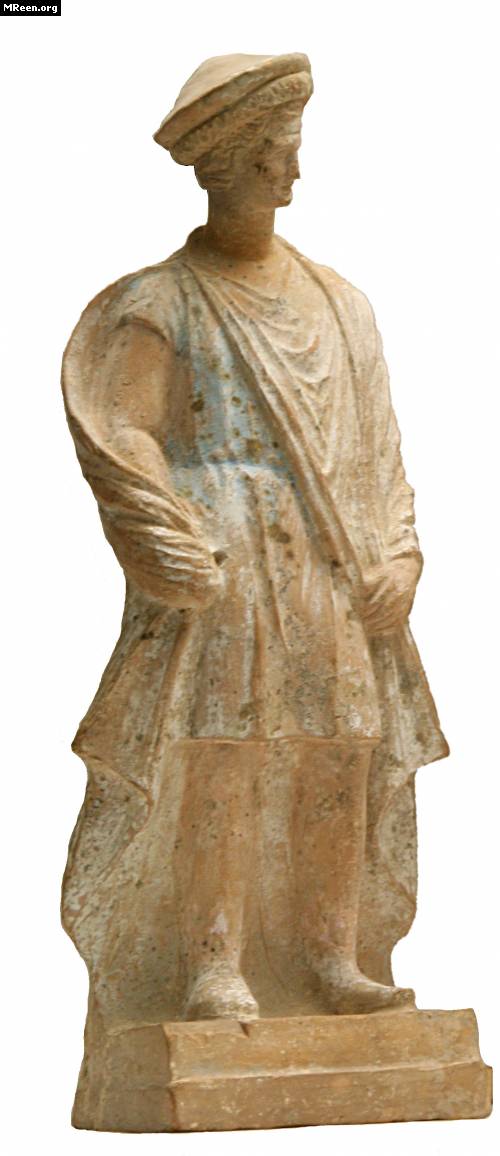
The same sleeves could be obtained by tightening with a belt another type of chiton, which was sewn according to the logic of making clothes that is more familiar to us: approximately like a sleeveless shirt. Perhaps we see just such an option on the Taman relief.
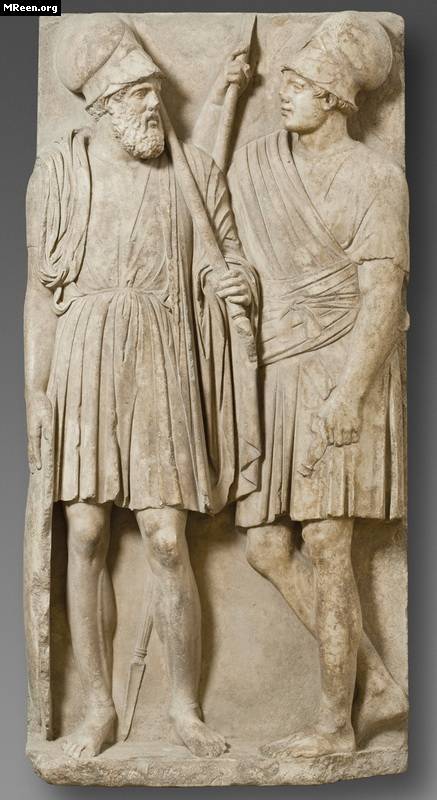
Perhaps this design was used when using denser fabric.
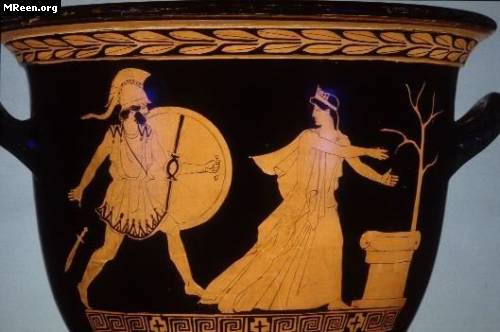
Belt.
The chiton was girded with a belt. The belt was woven. On a machine, reed or planks. With or without brushes.
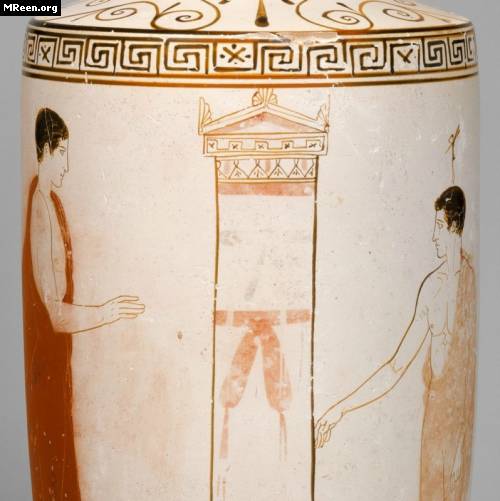
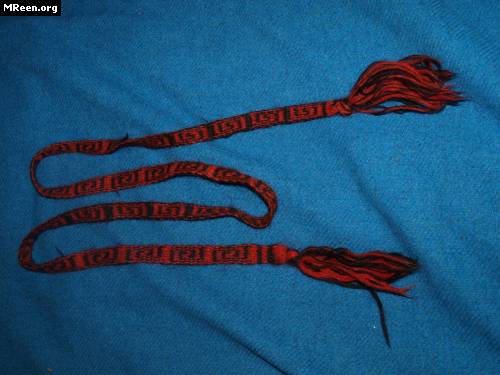
Usually, attention is not focused on him in a suit. Often it is covered with a chiton; even a braided cord or, for example, a sling will do.
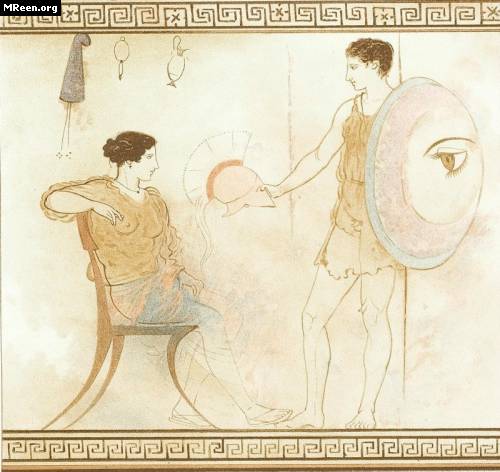
Fur/leather “tunic”
Images of similar clothing, clearly made from leather or skins, have reached us. Considering that our climate is very different from warm Greece, such finds are extremely important for us.
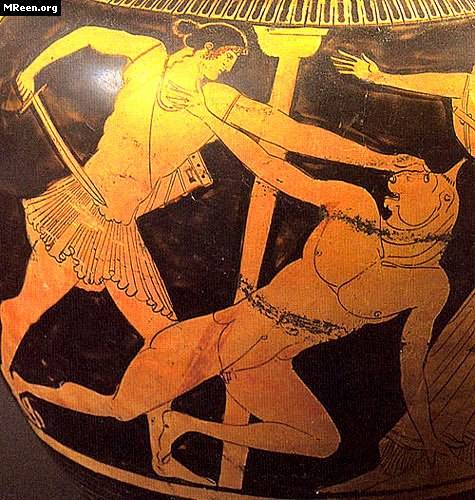
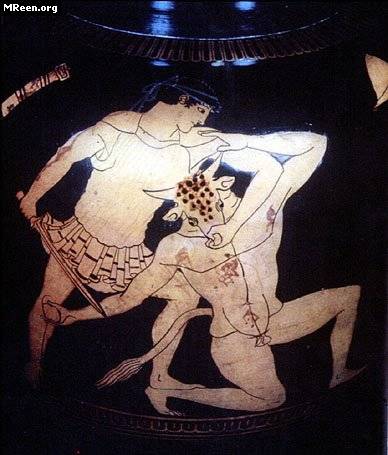
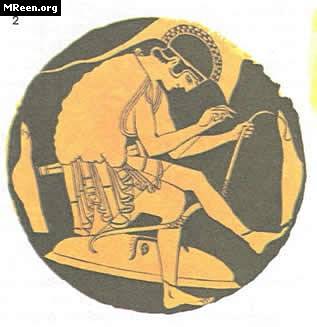
Chlamys
Mainly travel and military raincoat. It could be worn either with a tunic or as the only clothing.
Material - wool. Judging by the descriptions and logic, it can be quite dense, including fleece. Homer's “shaggy cloaks” refer precisely to chlamys-like clothing.
The design is also much simpler. On average, this is a rectangle of 2 by 1.5 meters. It may be a little larger or a little smaller, depending on the build of the chlamydia.
It is worn as in the picture, fastened with a fibula on the right shoulder. The right hand remains free.
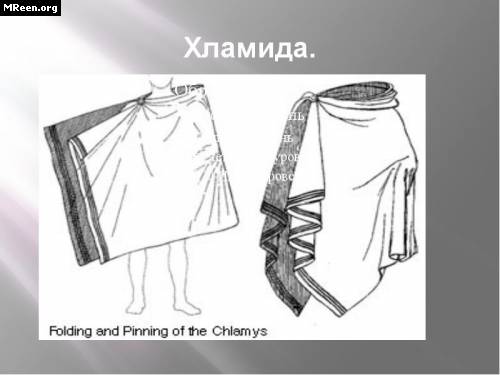
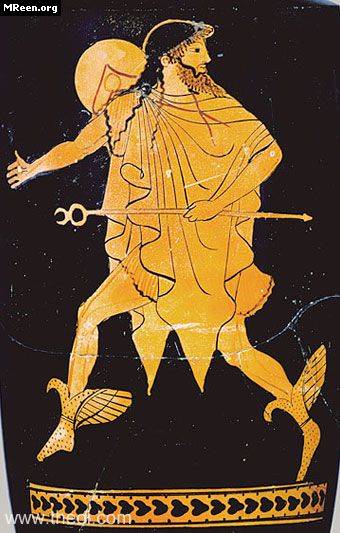
Pay attention to the pictures: if you look closely, you will see small weights on the hanging corners of the cloak. They could be either bronze (copper, gold) or lead. The latter were most likely sewn into peculiar woven “bags”. The weight of such a weight is quite small. In terms of dimensions, it is approximately the size of an early medieval button, maybe larger. Its purpose is to make the edge a little heavier so that the clothes drape better. There is no need to make it too healthy. Of course, with a raincoat with heavy weights it will be possible to effectively retrieve phones in the gateway, but when worn (especially when running), such a mantle hits its owner quite hard.
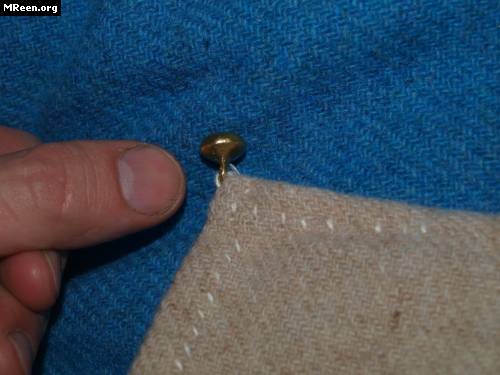
There were also other ways to wear these cloaks.
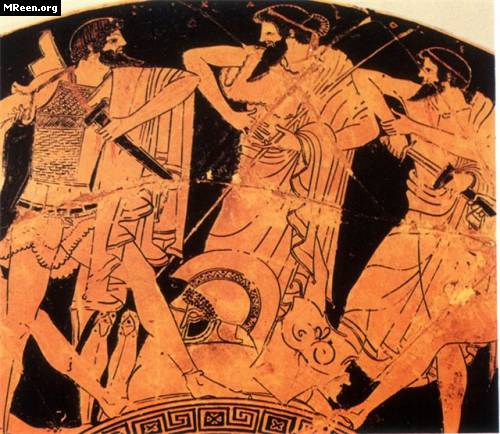
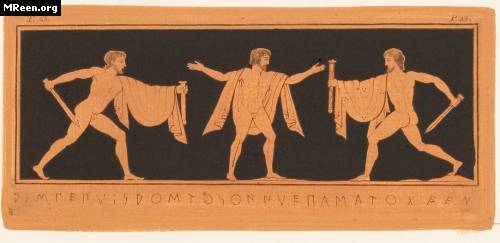
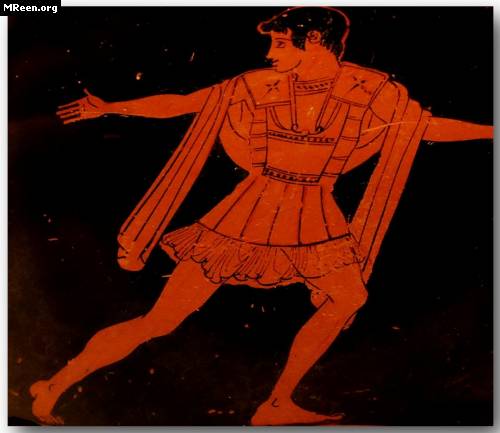
Again, see the Taman relief in the section on chitons. There is a cloak, most likely a mantle, wrapped like a roll-up and tied with a belt on top.
It should also be noted that cloaks of this type were also made from other materials: Aristophanes mentions a leather cloak in the comedy “The Birds” (alas, the author does not speak Greek and is not familiar with the original source, but perhaps this cloak was like a chlamys. Or perhaps it is correct another translation, where all this is translated as “breastplate” (possibly a tunic).
In addition, sometimes images show the use of skins in a manner similar to chlamys (as shining example one can cite Hercules with his lion skin, which he often wears in fine art like a cloak), as well as fur cloaks, as in the chthonic image below. Such products, presumably, had a purely utilitarian meaning and were used mainly by the dense rural population or in some extraordinary cases when protection from rain or cold was necessary. By the way, note that the fleeing shepherd’s cloak is tied in a knot.
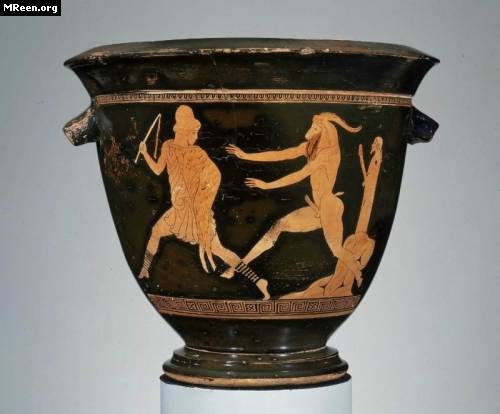
Himation.
This is, as they say, a decent cloak for a decent Greek. In this form, you need to be, for example, in a national assembly, recline at a symposium, make sacrifices to the gods, or simply walk in honor around your native city.
Material - wool. The choice of wool here should be paid Special attention. It should be soft and textured enough to drape well and not slip when wrapped. The hard fabric will bulge, but the “slippery” one will prevent you from getting wrapped up - a couple of movements, and the himation will end up on the ground.
Wool that is too thick, stiff or frayed is unlikely to be suitable for a himation. When purchasing, hold the fabric to your shoulder and see how it drapes, whether it slips or not.
In shape it is the same rectangle with approximate dimensions of 1.5-2 by 3.5-4 meters. BUT! Before making your himation, I would recommend experimenting with a piece of some cheap fabric, such as calico, to see how it all looks in the end. The dimensions of the himation are quite individual, and taking into account the amount of tissue spent on it, it would be very disappointing to make a mistake in the calculations. Take calico with a reserve, try wrapping yourself in it, both in the images and in other ways, and see what happens.
They usually wore it “to the right”: they left the end hanging from the left shoulder, passed it along the back, under the right arm, and brought it either back to the left shoulder, or left hand, like on a picture.
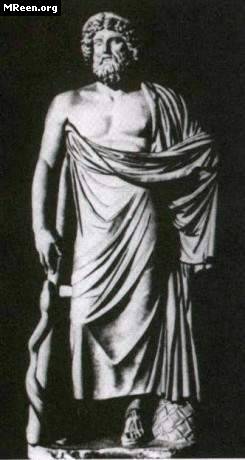
However, the good thing about Greek clothing is that it can be draped in different ways.
Without forgetting, however, about the rules of decency. In general, the Greeks paid attention to the decency of clothing increased attention. Wearing clothes appropriately and the ability to drape them properly was considered a sign, among other things, of education, civilization, nobility and in general. This especially applied to the himation, as a “ceremonial-weekend” attire. Let's make a very simplified, imprecise and rough, but, I hope, understandable analogy. A hoodie with the inscription “enemy of man” can be worn on a T-shirt or on a white body, even with jeans, even with shorts, even with combat boots, even with sneakers, even with conceptual flip-flops. But if we wear a three-piece suit with green shoes, then 99% that it will not be very good.
There were many peculiarities of wearing a himation. So, it was bad form to “grow out your left hand”; only the right was open. Only closer to Hellenism did some figures like Aeschines, speaking to audiences, discover it. Decency also concerned the size and type of himation: a cloak that was too short was a sign of a hillbilly who was used to walking on guanoterra, and, for example, his ill-wishers tried to mock Alcibiades for his excessively long and fluffy cloak that dragged along the ground...
Such nuances “die” first. A hundred years from now, our descendants are unlikely to understand why and by what unknown signs their contemporaries guessed in people wearing seemingly identical jackets from the beginning of the 21st century: a participant in the congress of agronomists, a homosexual director, a brother, or a museum worker.
To sum up, we will probably never know all the features of decent behavior and wearing clothes.
And this is not the main thing, you need not only to know, but also to be able to do it. You won’t be able to wrap yourself in a himation just like the respected people depicted above on your first try.
In general, most likely ancient Greek If he had seen our modern attempts to dress decently in ancient Greek style, he would have decided that this was an action from the unfamiliar genre of tragicomedy. But so that he doesn’t feel bad at all, before wearing clothes, especially formal ones, it would be nice to learn in detail, study and try out in practice at least what is known to modern humanity. And, of course, focus on images.
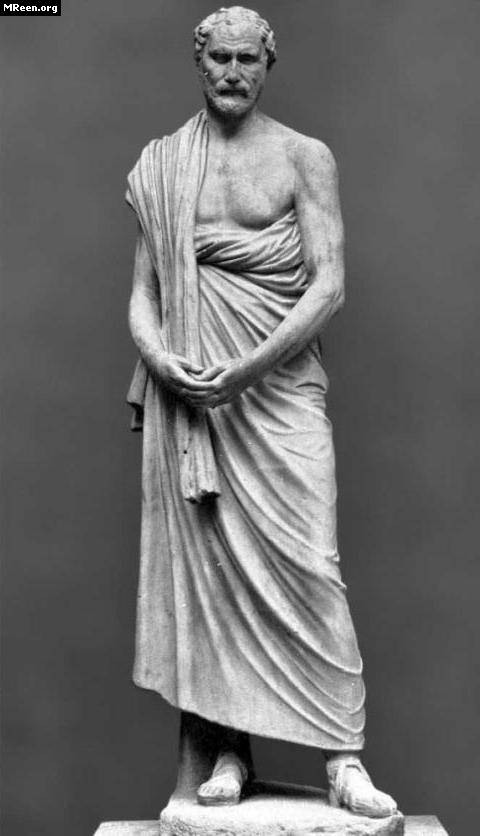
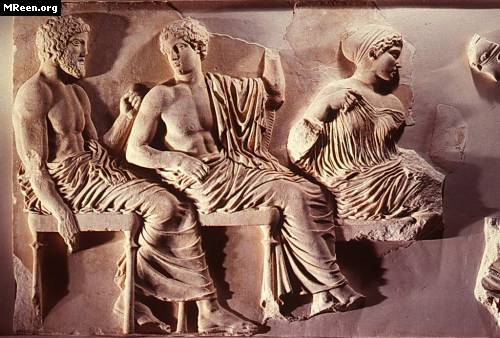
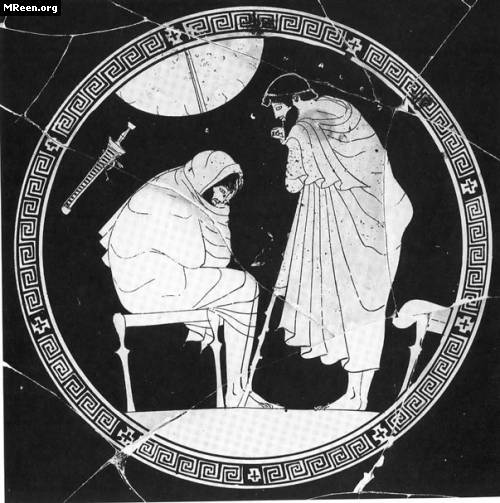
Hats.
Pylos - most likely a full-felt felt cap.
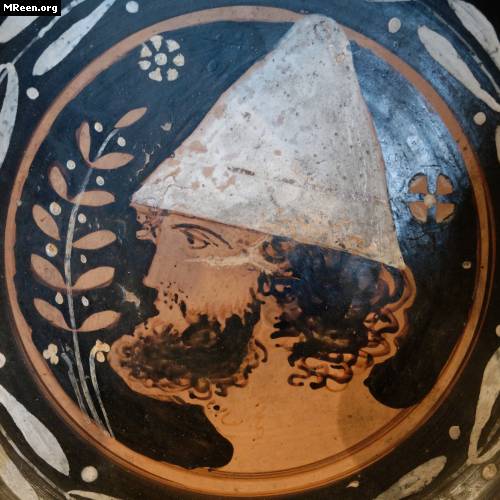
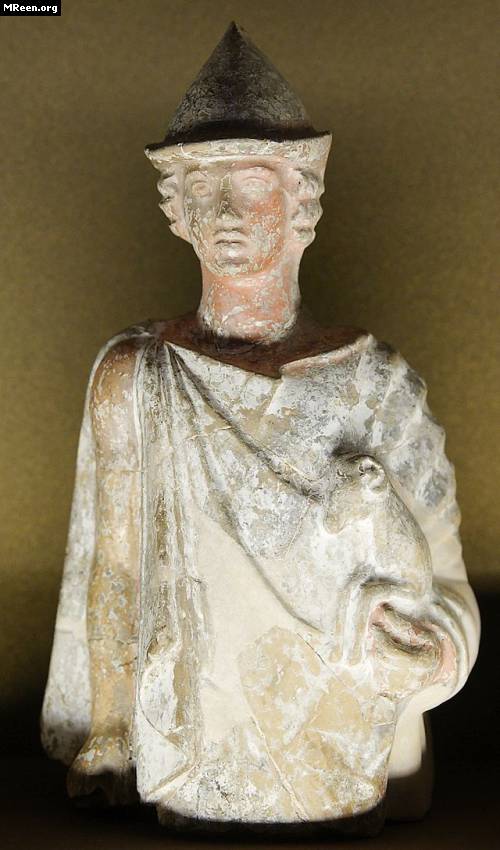
A helmet of identical shape has the same name. One can assume that such a thick cap is used by “homeless people” instead of a helmet.
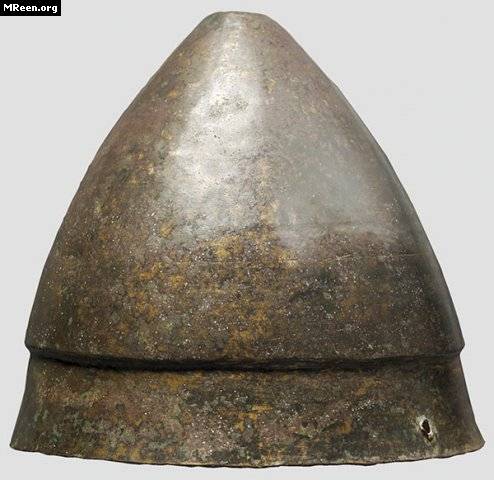
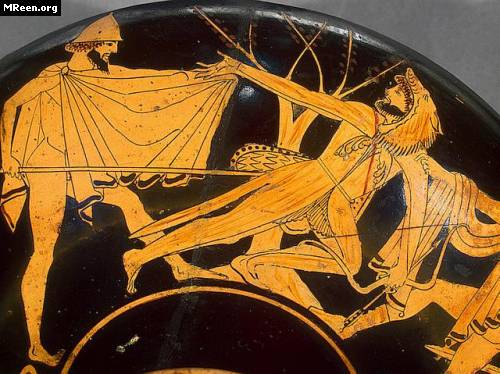
Petas - the hat is probably most often also made of felt, but it seems possible to admit the existence of straw options. Used for travel and also by horseback riders. The shape of the petas was quite varied, from a clearly defined hat-like design to a strange design where the central “extruded” part was clearly smaller than the diameter of the head.
Often the hat has a kind of “pip” at the top. It is also worth noting the presence of straps with which the petas was tied on the chin and held in place in the event of being thrown back from the head.
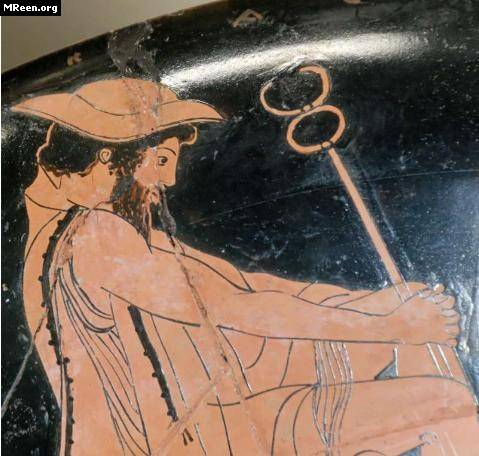
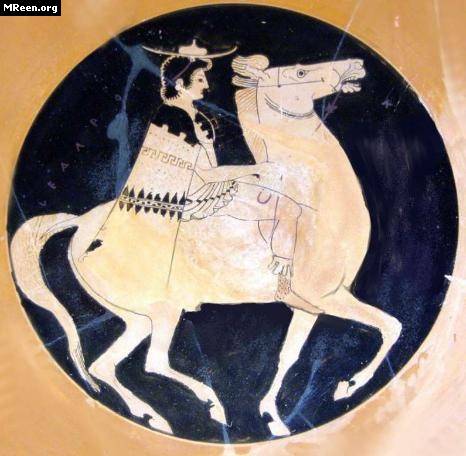
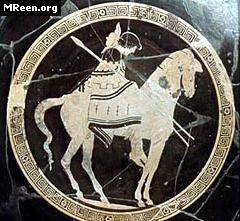
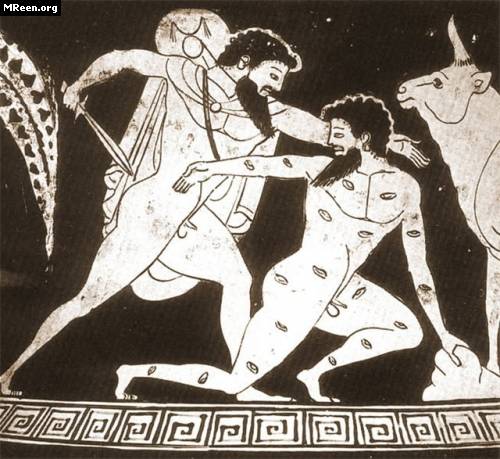
Kine (kühne) described as a felt or leather cap for sailors/craftsmen
Canonically, it is presented in the form of a kind of cameo (for some reason I can’t find a suitable illustration, when I find it, I’ll definitely add to the article).
It seems that this definition could include quite large group headdresses, which were also knitted and possibly sewn from pieces of woven material/leather.
Pay attention to the resemblance to a pompom and the circular stripe at the top of the hat.
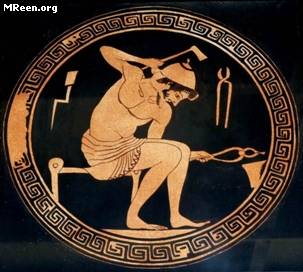
probably, knitted hat with a "beep".
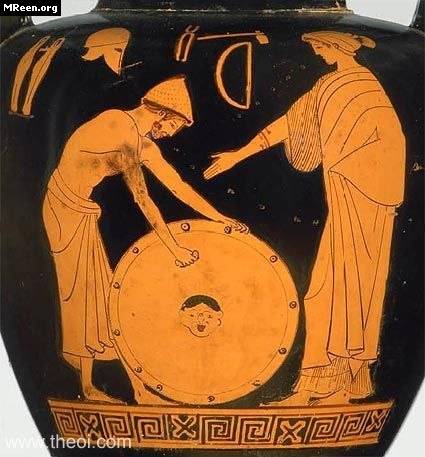
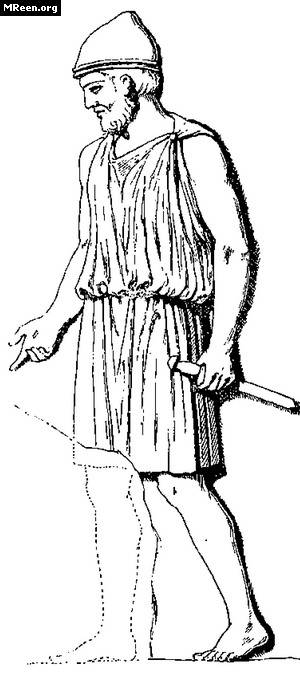
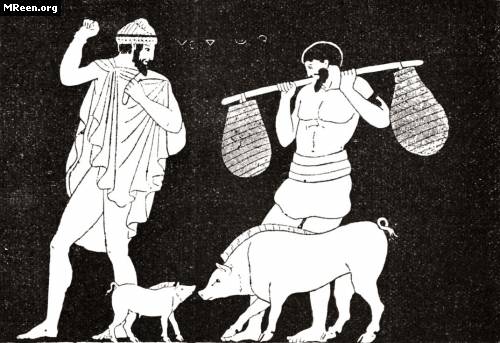
It should also be noted other hats . First of all, this is probably a peculiar fur hat, present in images of rural people.
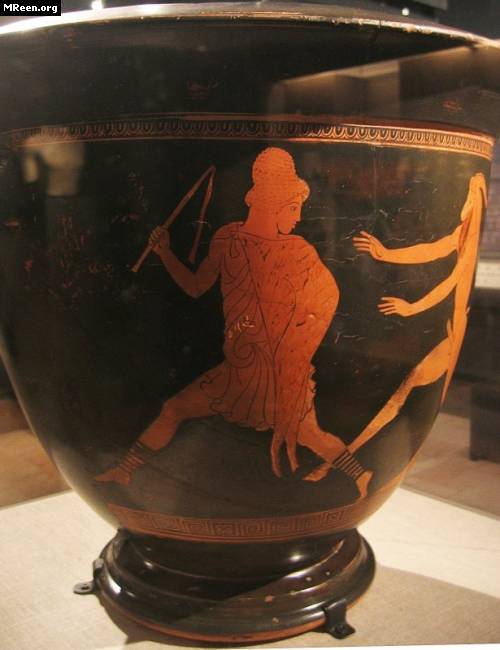
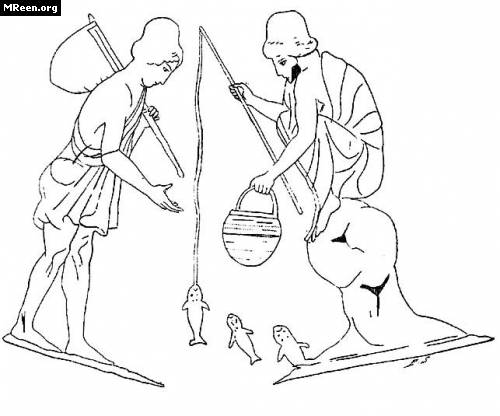
The headdress, which in appearance resembles a pilos, but has small folded brims, thanks to which it is somewhat vaguely similar to a “Tyrolean”, is also most likely solid felted. It is also likely that this was one of the ways of wearing a pilos.
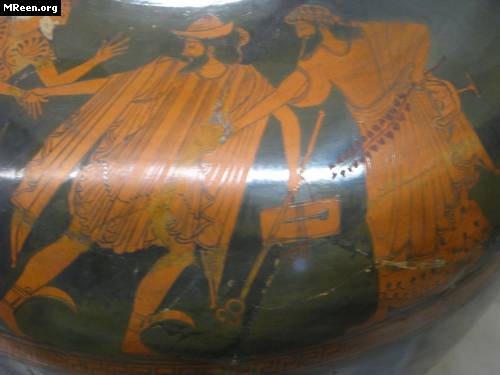
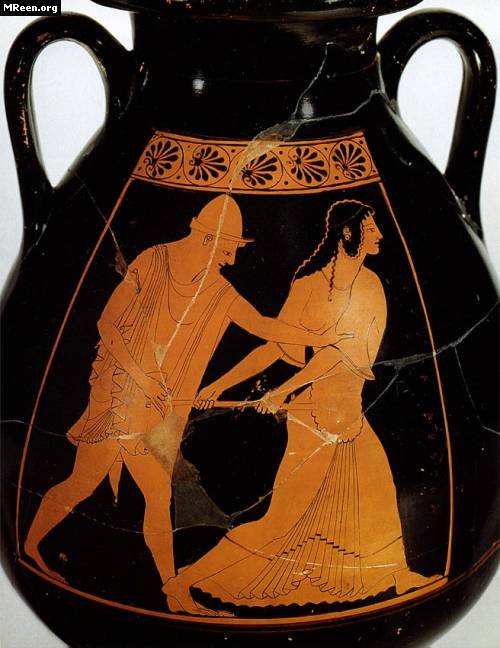
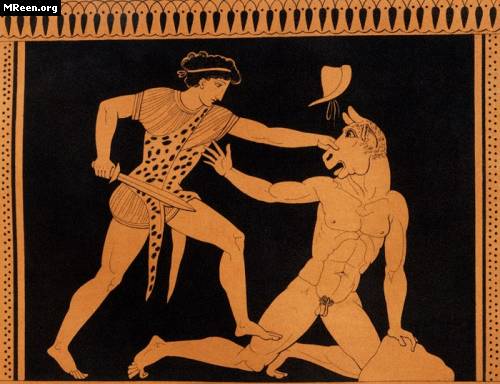
Here we also mention balaclava :
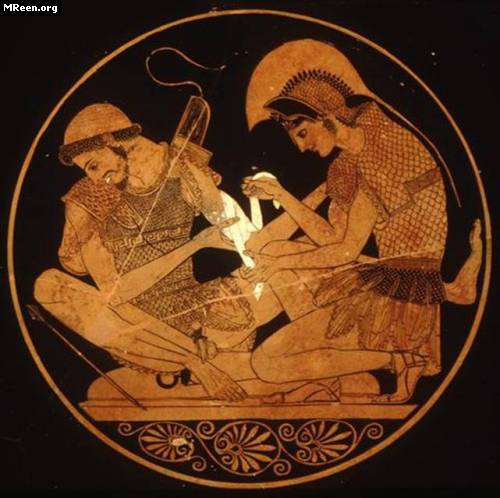
Sticking out from under helmets
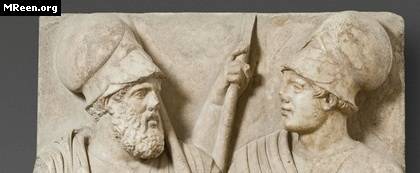
Wreaths and ribbons
Here you need to take into account that these are quite specific headdresses, often used in special cases(for example, at symposiums) and having different meaning. For example, ribbons (woven, embroidered) that were tied around the head were often a reward for athletes for winning competitions and at the same time evidence of this.
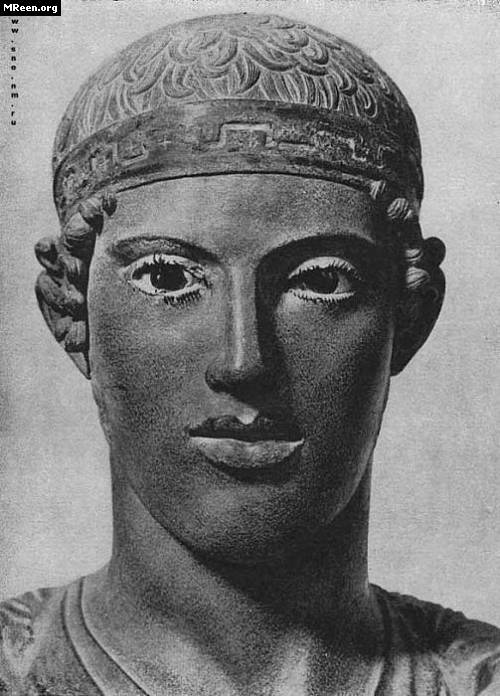
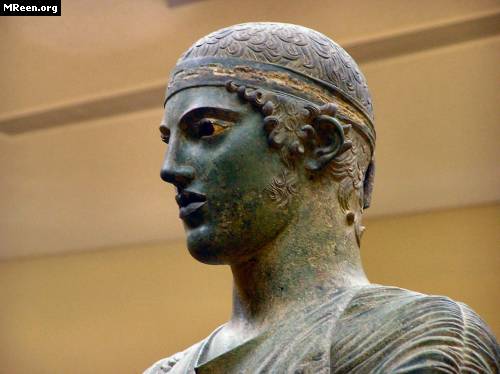
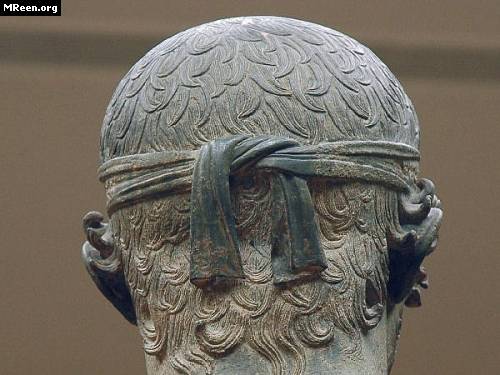
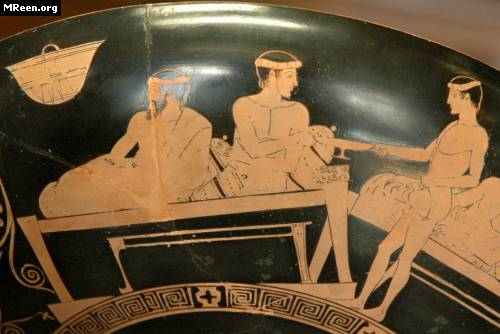
They played a large role in the life of the ancient Greeks and were distinguished by rare diversity. Athletes who won competitions were awarded wreaths; the wreath was used as state award Finally, the wreath was an integral part of the celebration.
The most famous to modern man- a laurel wreath, an integral symbol of winners and triumphs of all stripes.
It was also a reward at the Pythian Games, famous in Ancient Greece. Other games had their own type of wreath - at Olympic Games ah - olive, in Nemean - from celery, in Isthmian - from pine branches. Each type of such wreath had its own special meaning. Thus, the laurel is a symbol of Apollo, in whose honor the Pythian Games were held, the wedding with a wreath of wild olive was explained by the fact that Hercules, who founded the Olympic Games, established this. In addition, the plants also carried a certain semantic meaning. For example, celery was very closely associated with mourning, funerals and the like.
In addition to the four above-mentioned pan-Hellenic games - agons, there were also many large and local sports competitions (in fact, the ancient Greeks organized competitions, which were also a kind of way of honoring the gods, with or without reason: Patroclus died - they organized games, went out to sea - they organized games), in which a certain type of wreath could also serve as a prize.
Award wreaths could also be made of metals. In the surviving written sources about the life of the Black Sea policies there are descriptions of rewarding for special merits with a golden wreath (in this case, as a rule, the weight of the wreath is indicated). Such wreaths are also found in burials. Moreover, you should pay attention to the fact that some of them are clearly votive, i.e. V in this case made directly for a funeral ceremony - they are very thin, fragile and clearly not intended for wear. Others were worn during the owner’s lifetime; the structure is more massive, and sometimes there are traces of repairs.
Wreaths were also used during sacred ceremonies. During various kinds of holidays dedicated to Dionysus, there were wreaths made of grapevine or ivy.
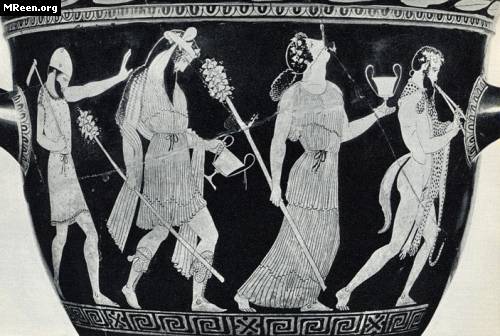
In addition to award wreaths, as already mentioned, there were also household ones used at holidays (weddings, symposiums, religious celebrations, etc.). Such wreaths, in addition to those established by tradition for certain celebrations, could be very different: they were selected according to color scheme, even aroma. For example, the case of Alcibiades coming to a symposium wearing a wreath of violets is described. There was even a type of women selling wreaths who were already selling finished goods woven from the most different colors. Well, Xenophon’s soldiers, having settled down for a rest in an unknown barn in an unknown hole on the edge of the world, for lack of anything better, crowned themselves with wreaths of hay and straw.
In short, it is not forbidden to feast beautifully and crown yourself with wreaths.
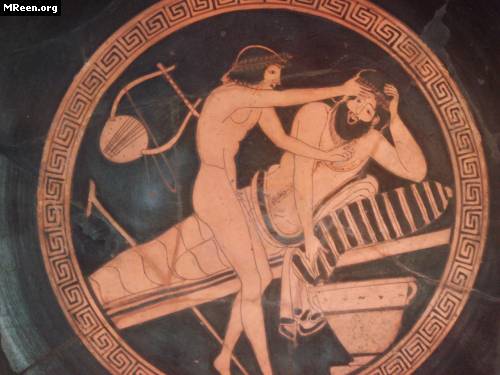
Decorations
Here we have two contradictory points. On the one hand, the Greeks considered the use of any jewelry unworthy of a man. On the other hand, it is clear that the fashion of decorating oneself, being pampered and falling into insignificance has always haunted humanity.
But still, we can say quite confidently that the abundance of dartsupags, especially the presence of such things as hryvnias, earrings, rings, bracelets, is a sign of a modern Vikingos with an effeminate husband, a barbarian, and in general - something obscene and not worthy of respect. Such objects can be found among a Thracian, a Persian, or a woman, but not among a Hellene.
However, this does not mean a complete absence of jewelry.
Fibulae
Brooches were often used to fasten cloaks and pin the chiton on the shoulders. I won't talk about them. Because the ideal that the article unsuccessfully strives for is simplicity, pragmatism and minimalism. Besides, I don’t understand them at all.
Well, an example for drooling.
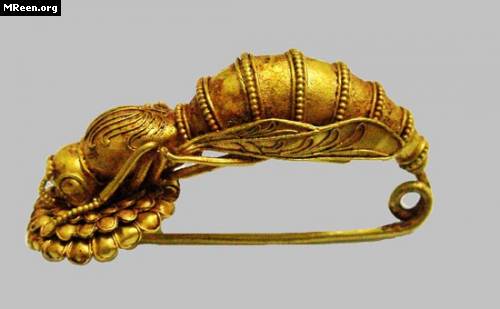
Rings
Another type of trinket accessible to men were rings. They were different and, as a rule, with a seal. 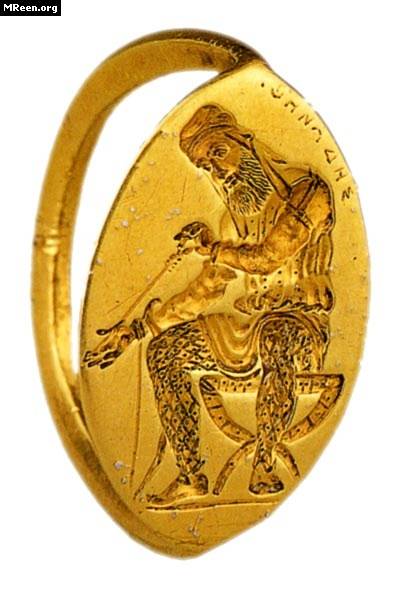
Some amulets could also have been used, especially in Hellenistic times.
Shoes.
To be honest, I don’t really want to delve into shoe topics in detail. This is, at least, for a very long time. So in short.
Ancient Greek footwear is far from being limited to the well-known sandals. There were a huge variety of types and options for shoes. Here we will touch on some aspects of manufacturing and interesting, from the point of view of the Russian people and our climate, options.
We remember that the modern centimeter or so saddle cloth was absent in those distant times. The maximum thickness of the skin could be 3-4 mm, well 5 =). At the same time, the workmanship was quite varied, and the skill of the shoemakers was extremely high.
Shoes could be decorated with various ornaments and could be painted.
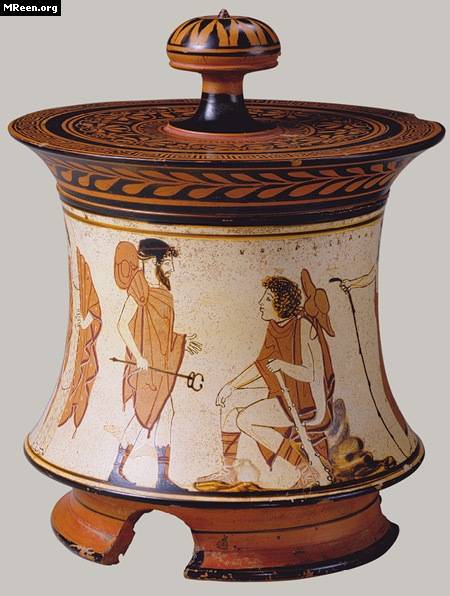
They could do everything on the soles with nails, including inscriptions like “follow me” or something like that of one hetaera.
Very few shoes of the ancient Greeks have survived. Personally, I (although this doesn’t say anything) know only “sneakers” from the 3rd century BC. from Hellenistic Egypt.
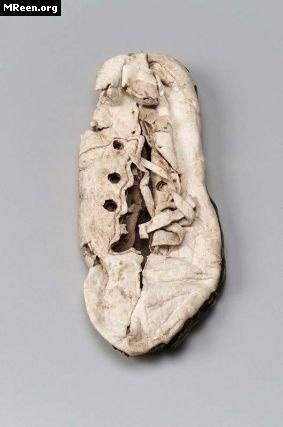
There are also quite a few finds of late Roman shoes and Roman caligas - soldier's sandals. There is reason to believe that the design features of the tap-making schools were similar: this is a sole to which something like this is nailed
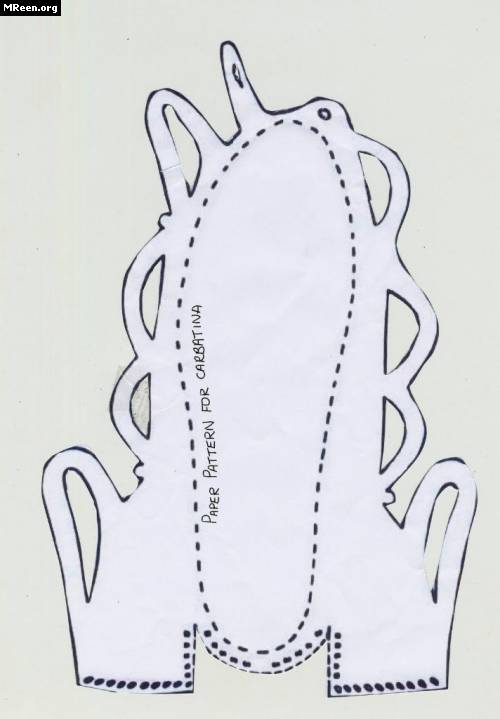
Then we put/glue/sew another leather insole on top.
In some cases, the upper could be sewn to the sole, as on modern boots. We notice the difference - we will have a multi-layer sole, reinforced with studs, and not a thin sole sewn with a reverse seam to the top, as in early medieval or medieval shoes.
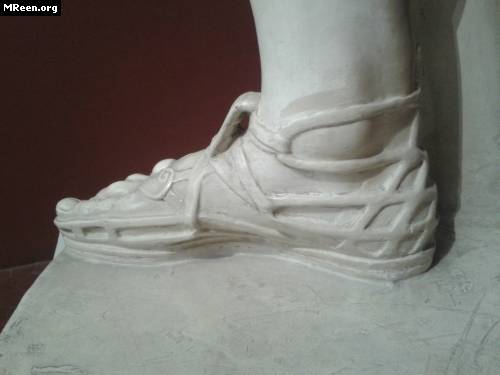
However, there were exceptions. First of all, it is worth noting the so-called. Scythians, that is, borrowed Scythian shoes that could be worn by residents of the Northern Black Sea region (naturally, not in a pretentious setting). In order not to explain for a long time, let us give as an example an excellent reconstruction performed by Yakov Vnukov.
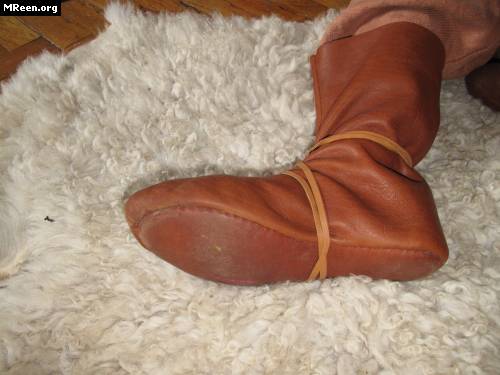
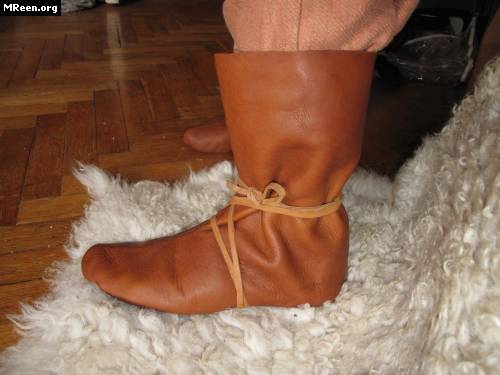
A local version of the pistons, apparently called “carbatides,” was widespread.
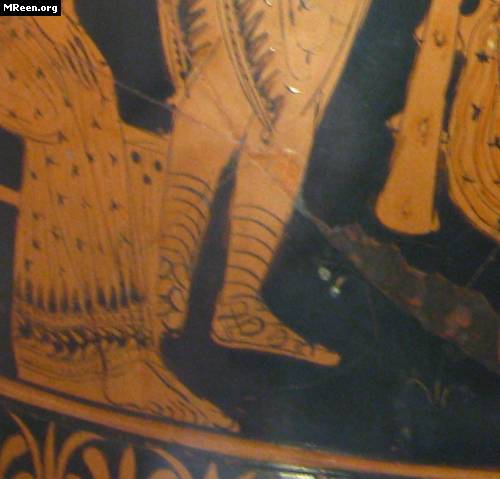
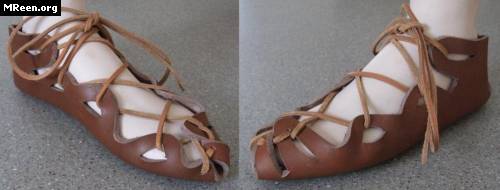
Sandals with hard soles could have a similar top shape.
In addition, it should be noted that there were various boots, most likely of Eastern or Thracian origin.
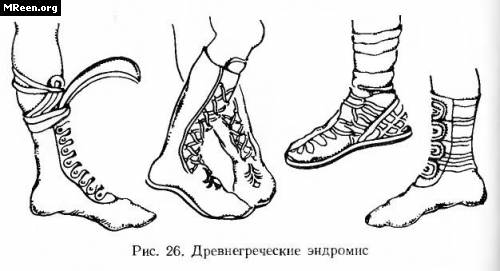
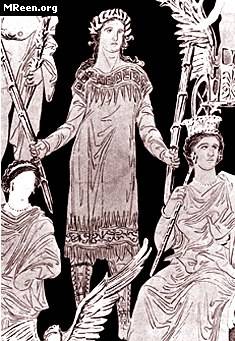
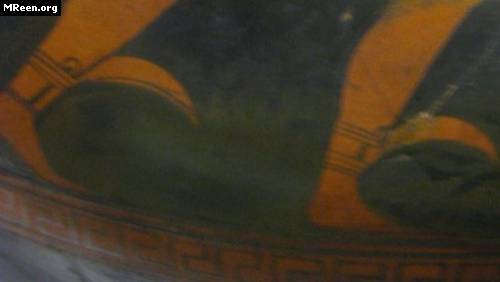
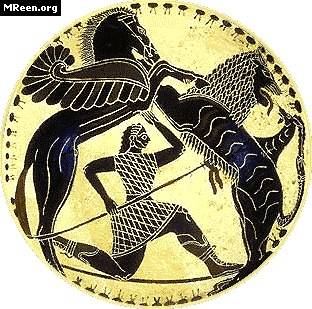
Thracian “boots” were distinguished by characteristic scallops.
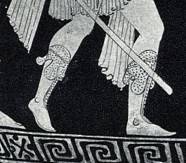
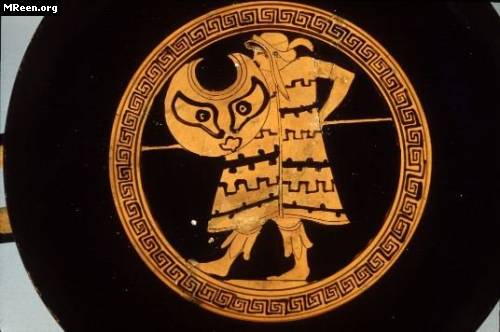
Let's note some more interesting views shoes.
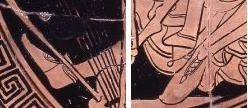
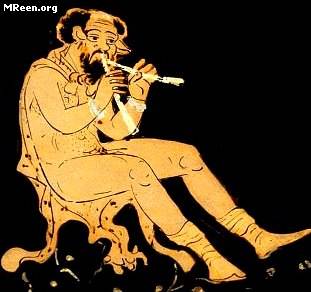
Socks and windings.
Upon closer examination, all this was found in abundance.
The windings were most likely woven entirely, the socks were knitted with a needle and, possibly, with a crochet hook.
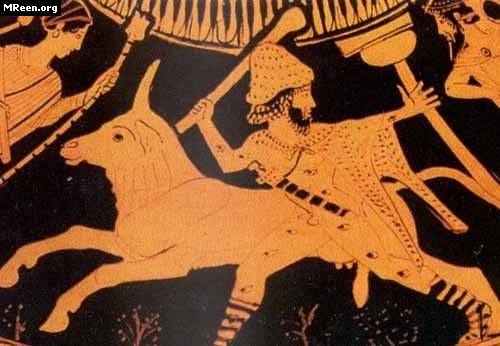
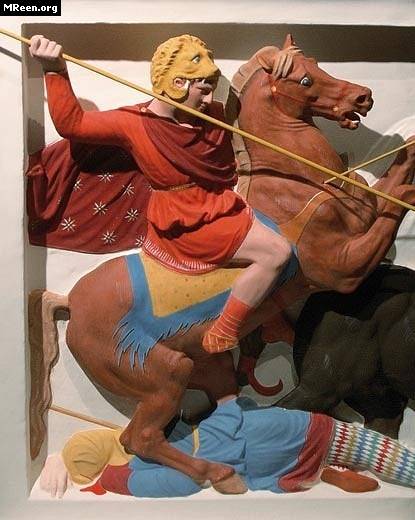
Hercules has windings with a pattern (apparently woven)
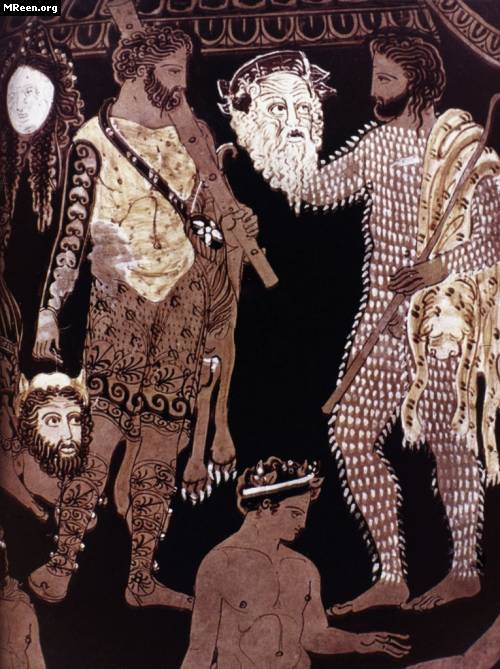
As an option, perhaps as a way to pull the owl onto the globe version, use fabric/felt socks and gaiters from our northern neighbors
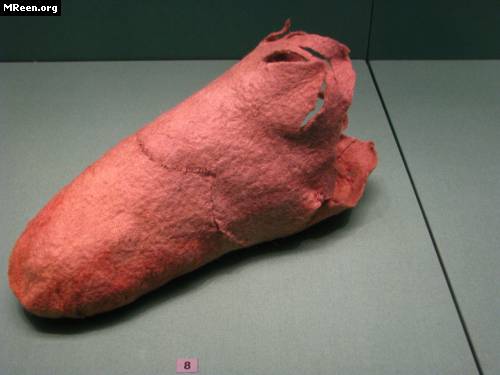
![]()
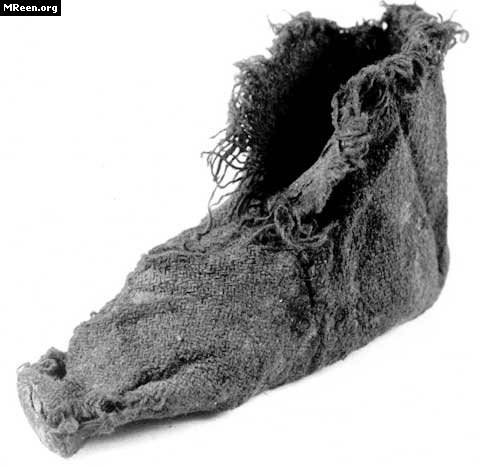
Bags
Handbags and wallets hanging on the belt, in which all the goods are stored, this, alas, is not about the Greeks. In general, you need to remember that a free and wealthy citizen, going to a national assembly or somewhere else to shout and drink, had a specially trained slave to carry his things, which is much more convenient than any wallets. Well, he, as well as a person who was going somewhere for a long time, already took more serious bags.
However, there were bags and wallets, although any kind of clinging to the belt was not noticed anywhere. Such wallets are usually recorded (which gives an idea that shekels were placed there) when buying a girl
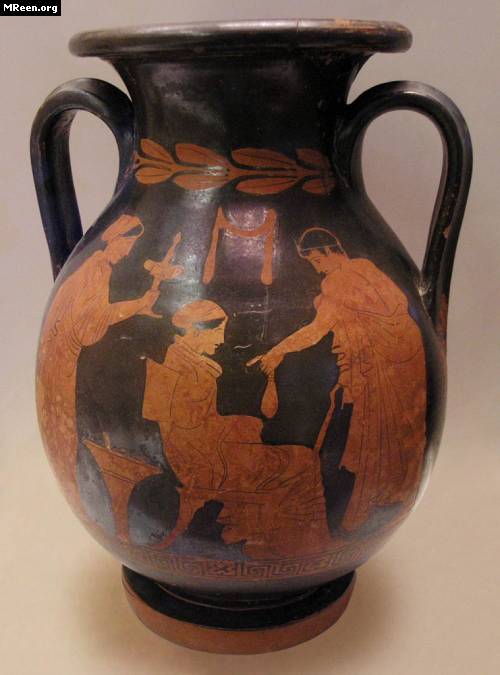
Or a boy
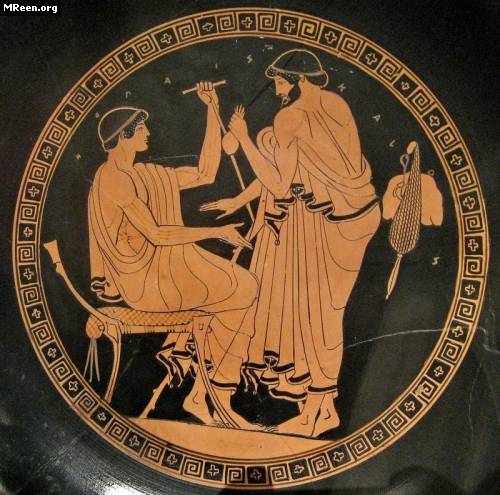
Notice the grid on last picture. They are quite common.
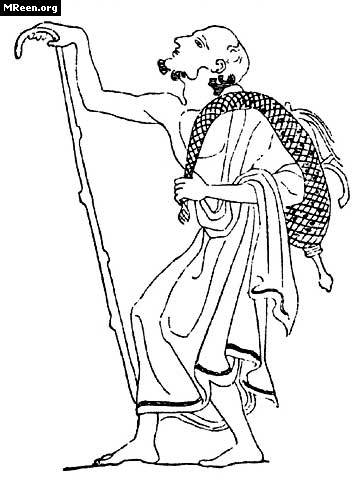
There are also all kinds of bags, which are usually called “shepherd’s” and “slinger’s bags”, although their purpose is clearly not limited to this
.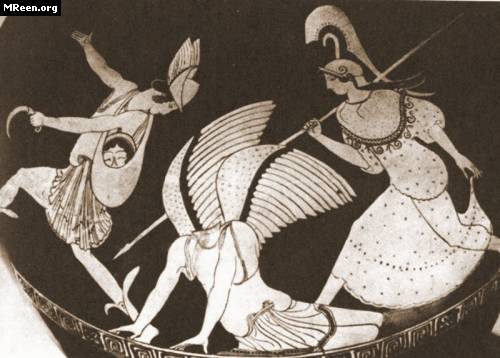
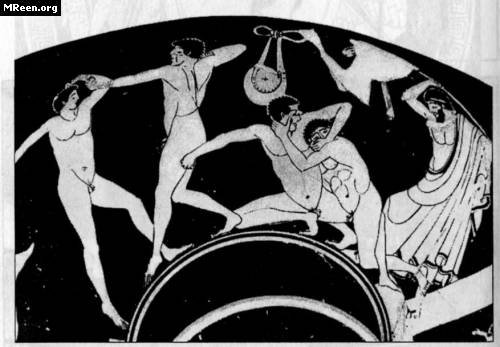
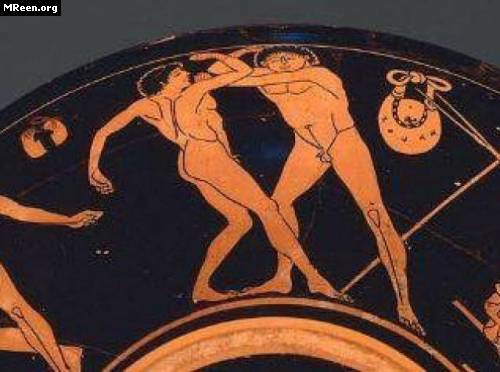
Gloves
There are references to them. In particular, the Persians were mocked for using gloves not to protect them from the cold, but to prevent anything from happening to their delicate skin. But, alas, I don’t know any images.
Staff
I almost forgot about one important thing. Costume free man often complemented the staff. It could have been just a sanded wooden stick
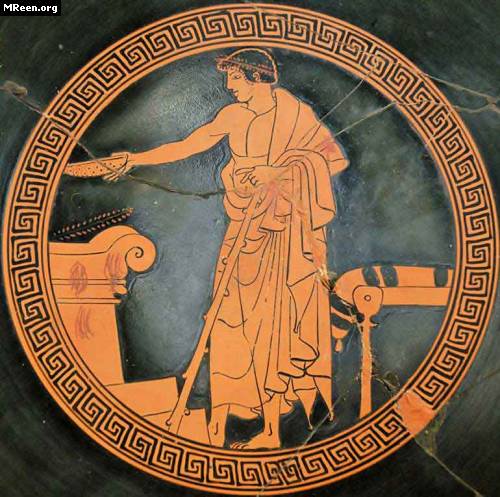
So is a carved staff with a carved knob, sometimes painted or covered with patterns.
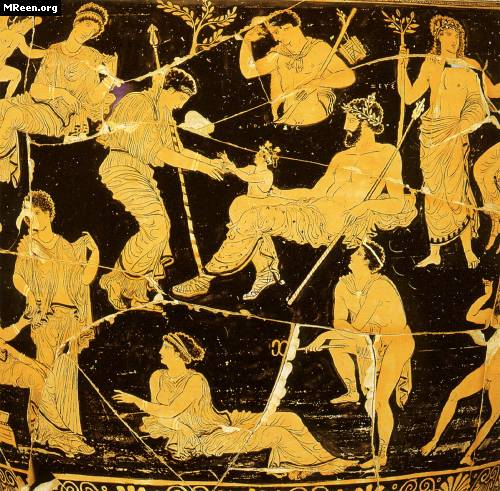
Bosporan men's costume
Well, finally we come to the most interesting part. As we see, the Greeks were quite insulated. We have already seen fur tunics, warm raincoats, socks and closed shoes. But for you and me, with our climate, this is clearly not enough.
As it was for the colonists in the Northern Black Sea region. Who thinks it's there all year round dry and warm, here are some consequences of Bora, not that far from the Kerch Strait

It is believed that by the 5th-4th century the so-called. The Bosporan costume is already fully formed. In short, this is a kind of tunic with sleeves, most likely worn under a tunic, as well as rather narrow trousers worn with closed shoes. The basis of such a costume is believed to be the borrowing of local (Scythian) elements of costume by the colonists due to climatic conditions and a certain mutual influence. However, one can argue with this, since the trousers of the Greek colonists, unlike the Scythian ones, are quite narrow in the images that have come down to us. And if this can be attributed to the characteristics of the iso-sources, then the clothing is clearly not open - “tunic” with long sleeves, worn under a chiton, is completely uncharacteristic of a Scythian costume. Moreover, both female and male.
I cannot say with sufficient evidence, but it seems that these could be elements of costume that the Milesians (Miletus is a city in Asia Minor), who brought out all the Bosporan colonies, borrowed from the Persians in an earlier period (Persian trousers - anaxarids, were probably narrower than the Scythian “harem pants”, they also had an open shirt), or some kind of Greek development, sometimes recorded on skysporan images, again, eastern, i.e. presumably Persian clothing, which occasionally penetrated into the Greek costume (tight pants, sleeves, etc.)
compare.
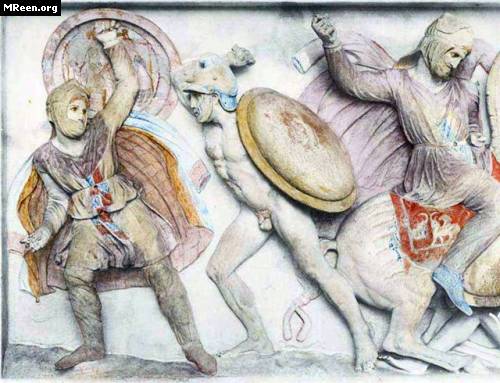
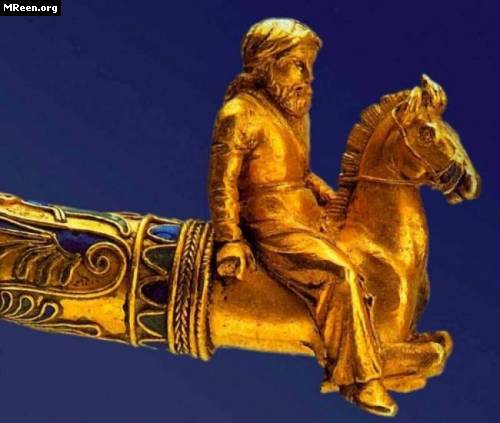
Two below. Here we see a shirt like a Persian one, worn without any tunic.
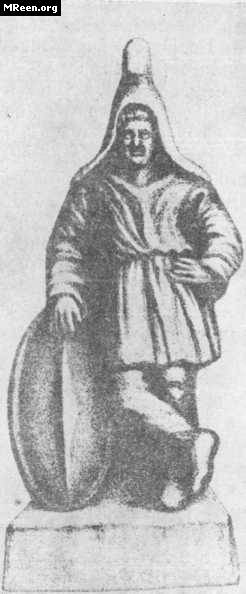
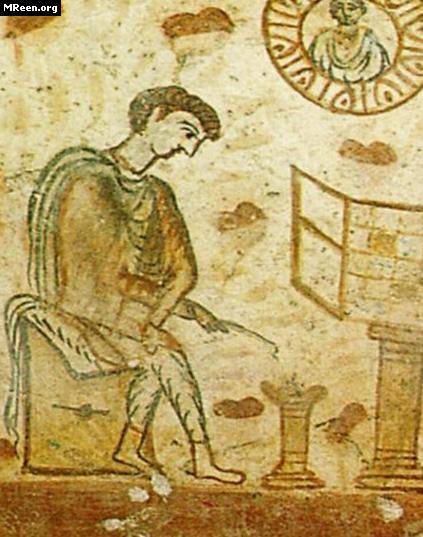
Somewhere around the 3rd century, the depiction of such a costume was already widespread in visual sources.
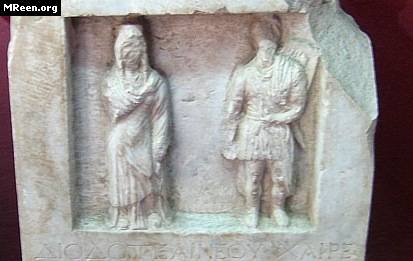
It is likely that the Greeks, until that time, in some sense shunned these elements of “barbarian” clothing, since wearing a Greek costume emphasized their (as well as the Hellenized representatives of the local population) belonging to Hellenic civilization. Purely Greek clothing was most likely used in special occasions, as well as what is called “decent society”. The clothing of the device described above could be used during operation and Everyday life, as well as on hikes and travels. Gradually, presumably, it became more and more common until it finally replaced the classic Greek costume (perhaps by the turn of the era). Along with it, a truly local (in our case, Scythian) costume was also used, either completely or in the form of separate elements. It is logical to think that it was used, first of all, by the local population who settled in the Bosporan cities and villages, and, of course, by the Greeks themselves.
Most likely, the material used for this type of clothing is wool, which is determined both by its purpose and by the traditions of Iranian costume.
But this is just a theory.
As for reconstruction, no one knows the exact cut of this clothing. Everything has come to us in the form of images. Moreover, we will not see pants above the middle of the thigh anywhere; the cut of the tunic is also difficult to recognize.
When cutting pants, free interpretations are allowed in the pattern itself, taking into account, however, the simplicity of such an archaic cutting. Here you can also focus on the neighboring steppe samples, which had a fairly simple cut of slightly tapered rectangular trouser legs and a diamond-shaped gusset. Most likely, there was no internal extinguisher. A cord used to tie a belt right over the fabric. However, since Bosporan trousers are not worn just like that, using a cord inserted inside will not be a great sin;)
You can try to make such obscenity as on these Pazyryk pants.
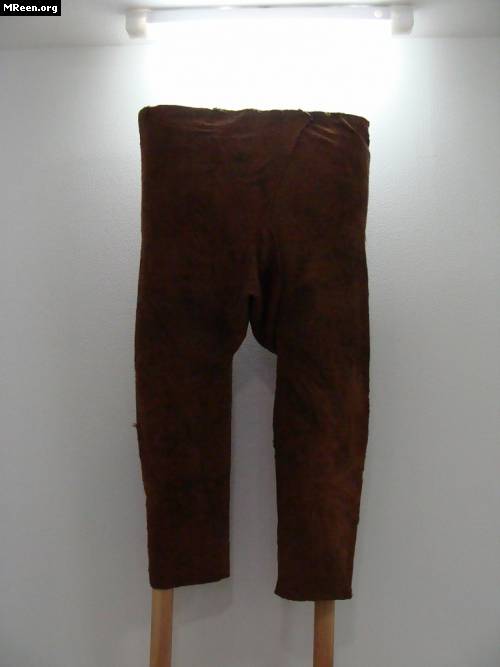
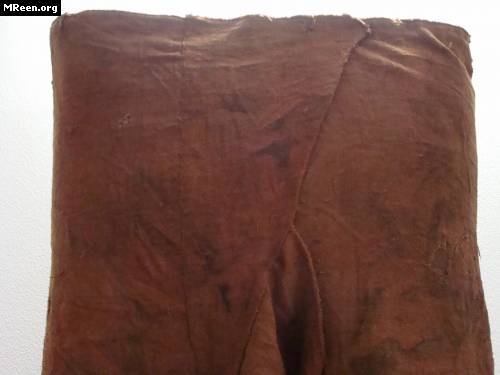
Clothing with long sleeves, as mentioned above, is also found in Greek images proper, but it is usually hidden under a chiton.

Sometimes such sleeves are decorated in an “oriental” style - with printed material or a multi-colored herringbone texture. Perhaps this emphasizes the non-Greek origin and perception of such clothing.
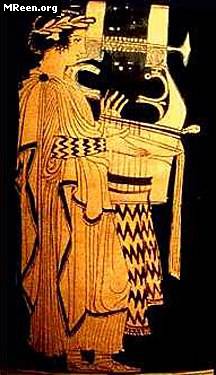
The cut, as already mentioned, can probably be correlated with the supposed cut (no shirts that have come down to us have been preserved, including here, too, fortune-telling on coffee grounds) of Persian open-loop clothing. Or with the later cut of Byzantine tunics.
Flat cut narrow sleeves and lack of wedges.
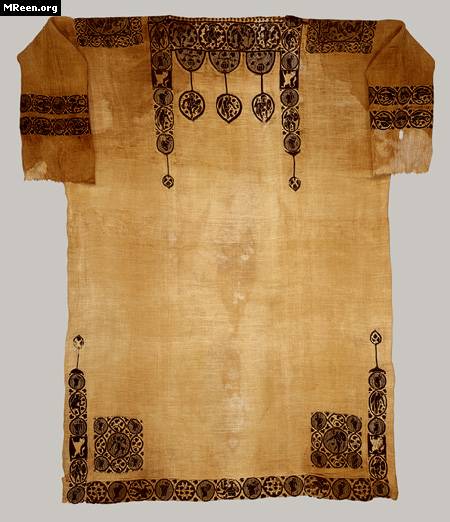
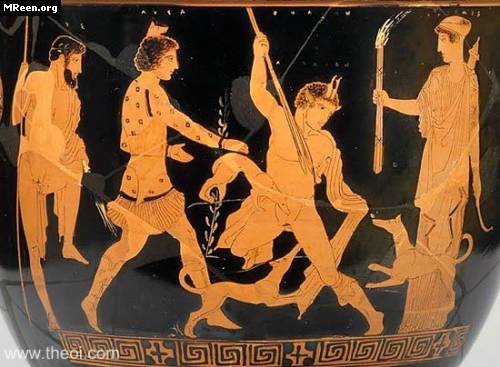
Something like this. About finishing (embroidery, textiles, printed fabric - sometime later).
Chiton
This article is about the clothing of the ancient Greeks. For the class of mollusks, see shell mollusks (Polyplacophora).
A man's chiton was made from a rectangular piece of fabric (about 1 meter wide and about 1.8 meters long), which was folded in half vertically and pinned at the shoulders with buckles. For more freedom movements during gymnastic and military exercises, the buckle on the right shoulder was unfastened. The bottom of the tunic was necessarily hemmed (an unhemmed, frayed bottom was a sign of mourning or slavery). The chiton was always belted, usually with a slouch. Its length depended on age and social status person. Most often it reached to the knees, but priests and officials in the performance of duties, as well as tragic actors during performances, wore long (ankle-length) tunics. Warriors, on the contrary, usually shortened their chitons to the very hips. While working, they wore a special type of chiton - exomis, which was a piece of rough linen passed under the right arm, fastened at the left shoulder and belted.
Wikimedia Foundation. 2010.
Synonyms:See what “Chiton” is in other dictionaries:
- (Greek chiton). The ancient narrow clothing of the Jews, which went down below the knees, over which another was worn. Dictionary foreign words, included in the Russian language. Chudinov A.N., 1910. KHITON Greek. chiton. One of the ancient men's clothing... ... Dictionary of foreign words of the Russian language
Chiton, otherwise clothing, robe (Exodus 29:5, John 19:23) the underwear of the Jews, both men and women; it also made up the lower clothing of the priests and Levites (Ex. 28:40). She put it on naked body like a shirt and had sleeves. However... ... Bible. Old and New Testaments. Synodal translation. Biblical encyclopedia arch. Nikifor.
Hoodie, mantle, shirt, tunic Dictionary of Russian synonyms. chiton noun, number of synonyms: 11 acanthochiton (1) ... Synonym dictionary
- (Greek chiton) men's and women's underwear of the ancient Greeks. Linen or woolen shirt, often sleeveless; belted himself with a slouch... Big Encyclopedic Dictionary
HEATON, tunic, husband. (Greek chiton) (source). The clothes of the ancient Greeks were in the form of a long shirt. Dictionary Ushakova. D.N. Ushakov. 1935 1940 ... Ushakov's Explanatory Dictionary
“Nannion covered the thinnest Ionic chiton with a blue, gold-embroidered himation (himatium) with a regular border of hook-shaped stylized waves along the lower edge. In oriental fashion, the hetaera's chemation was thrown over her right shoulder and secured over her back with a buckle on her left side. Thais was dressed in a pink transparent chiton fabric, brought from India or Persia, gathered in soft folds and pinned at the shoulders with five silver pins."
“Thais of Athens” I. Efremov
Probably many people associate it with marble. White marble sculptures ancient gods- Aphrodite and Apollo, Zeus and Neptune, Olympians frozen in marble - Discobolus, as well as marble columns of destroyed Greek temples, for example, the ruins of the Athenian Acropolis.
Artemis of Gabii
Dressed in a chiton with drapery
But not only marble was white, the clothes of the ancient Greeks were also white. At the same time, the Greeks in many ways strove to look like marble statues in their clothes - it was believed that not a single fold should wrinkle when walking. It was necessary to walk slowly and smoothly, maintaining a regal posture. And the Greeks could well afford such a gait.
In Ancient Greece there were slaves who coped well with the daily routine; as for the citizens - residents of the city-states of Ancient Greece, they preferred to spend time in theaters, at feasts, in disputes about literature and philosophy, or contemplating and enjoying the performances of speakers at central city squares.
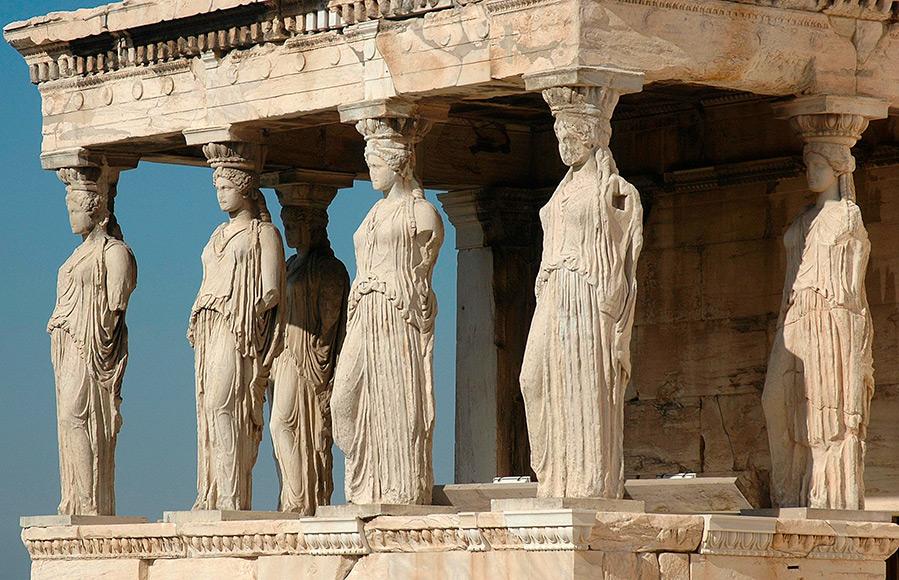
Fabrics for clothing had to be soft and elastic, because main feature Ancient Greek costume is drapery. The Greeks knew wool, and very often clothes were made from fine wool and linen.
Silk may have been produced on the island of Kos and Lydia. The Greeks saw cotton only during conquests Alexander the Great - cotton fabric was brought from India.
Chiton - men's and women's underwear, a piece of linen or woolen fabric folded in half, with a slit on the fold for the arm, and sewn on the opposite side, with a slit for the other arm. It was fastened at the shoulders with a fibula and tied at the waist with a belt.
The Greeks valued the craft of weavers. In the mythology of Ancient Greece, the goddess of fate Moira weaves a thread human destiny. The goddess Athena competed in weaving with Arachne, the best weaver in Greece, and defeated her by weaving plain fabric instead of patterned fabric. By the way, the Greeks did not like patterns, nor did they like colorful fabrics.
The clothes of the inhabitants of Ancient Greece were monochromatic - they could be blue, green, yellow, red. But he remained the best and most beloved White color. And only along the bottom of the fabric could there be a small geometric or floral ornament.
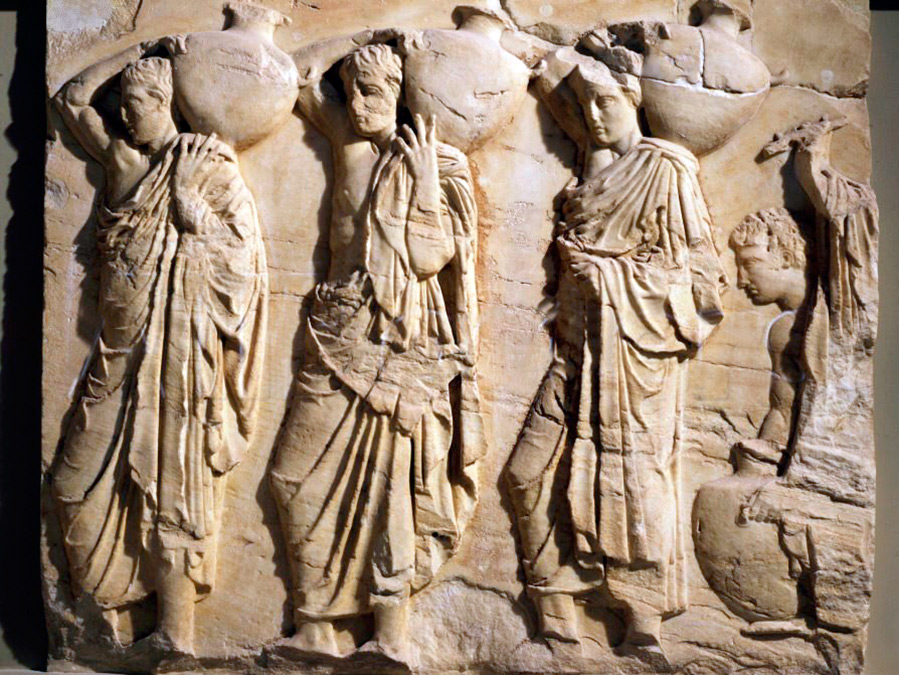
Relief of work ancient Greek sculptor Phidias "Water-Carriers"
Dressed in himation cloaks
The clothing itself was also simple - both men and women wore chitons, and over them cloaks - himation.
Himation (himation) - ancient Greek men's and women's clothing,
a cloak, which is a piece of rectangular fabric,
draped directly on the human figure,
fastened with a fibula.
The chiton, both male and female, was made from a single long piece of rectangular fabric - wool or linen. The fabric was folded in half and belted, and pinned at the shoulder with a fibula clasp. The chiton was sure to be draped. Men wore shorter chitons; women's chitons were most often floor-length. The bottom of the chiton must be hemmed. It was believed that a tunic with an unlined bottom was worn only by slaves and free people during mourning.
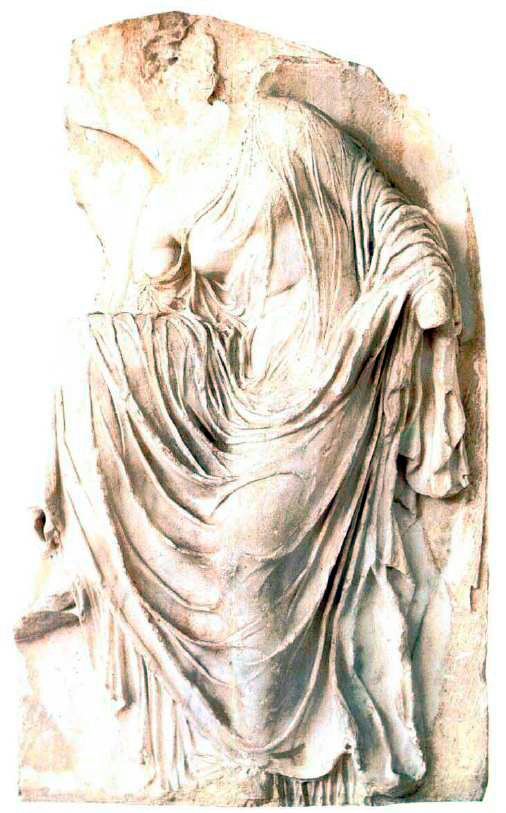
Relief “Nike (goddess of victory) tying up her sandal”
In addition to the chiton, women could also wear a peplos - a rectangular piece of fabric that was folded in half along its length, while the top of the fabric was bent by approximately 50 cm and, thus, a kind of hood was obtained (this lapel was called diploidy), on the shoulders the peplos was pinned with brooch clasps . The peculiarity of the peplos was the presence of an ornament; it was decorated with a border, as well as these clothes was not stitched and swung open on the right side while walking.
The outer clothing of both men and women in Ancient Greece was the himation cloak.
In order to feel like an ancient Greek, you will need to take a rectangular piece of fabric (1.7 by 4 meters) and try to wrap yourself in it. By the way, slaves helped the Greeks put on a cloak, and they then laid the hematium fabric itself into ideal folds.
They wrapped themselves in a cloak in different ways - the himation could be wrapped around the hips, throwing one of the ends over the arm, thrown over the shoulders, or completely wrapped in it.
Men most often draped themselves in a himation in this way: one end of the fabric was gathered into folds and dropped from the left shoulder to the chest, the rest of the fabric was on the back and passed under the right arm, then folded and thrown over the left shoulder to the back.
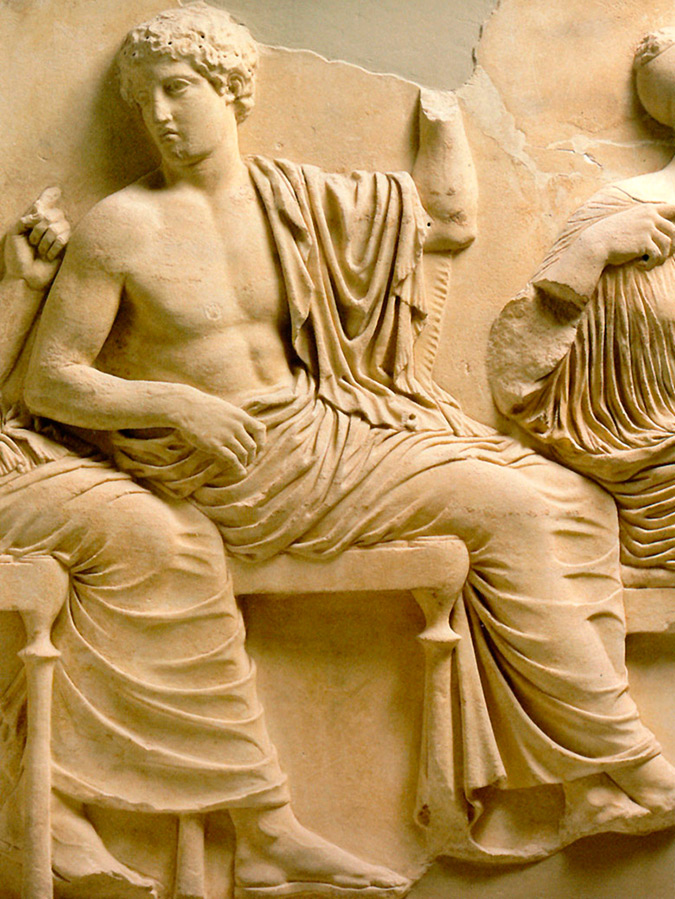
Fragment of an ancient Greek relief
The Greeks also had a more convenient version of the cloak - a mantle cloak, which was worn by travelers, and the ancient Greeks loved to travel. Just remember Herodotus, the author of the first book, dedicated to history various countries and peoples, although it can also be considered the first guide for ancient tourists.
The mantle cloak was draped over the shoulders, was short and decorated with ornaments. In addition to the chlamys, tourists of Antiquity also wore a petas hat, a wide-brimmed hat with ties under the chin, and endromids, high lace-up shoes with open toes. These shoes were also worn by hunters, the goddess Artemis, and Olympic runners. The shoes attached well to the foot and were therefore comfortable.
Chlamys - a rectangular cloak made of soft woolen fabric,
clothing of warriors and travelers, covering the left side of the body, fastened with a fibula on the right shoulder,
slightly above the knee length.
In addition to endromids, the Greeks could also wear crepides - shoes with thick soles, attached to the foot with leather laces. Or buskins - actors' shoes ancient Greek theaters, the peculiarity of which was a very high thick cork sole, something like a prototype modern shoes on the platform.
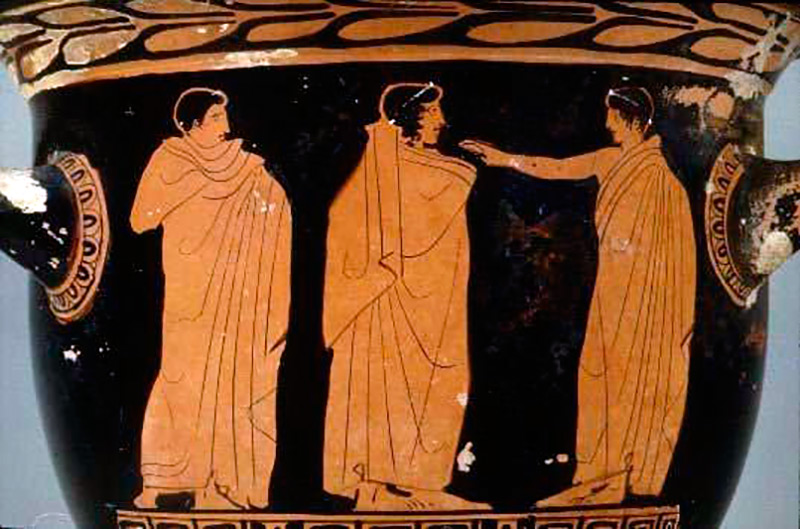
Red-figure vase painting
The figures are dressed in himation cloaks
Women most often wore shoes made of soft colored leather without heels. Also, women had to cover their heads when leaving the house - most often the edge of a cloak was thrown over their heads.
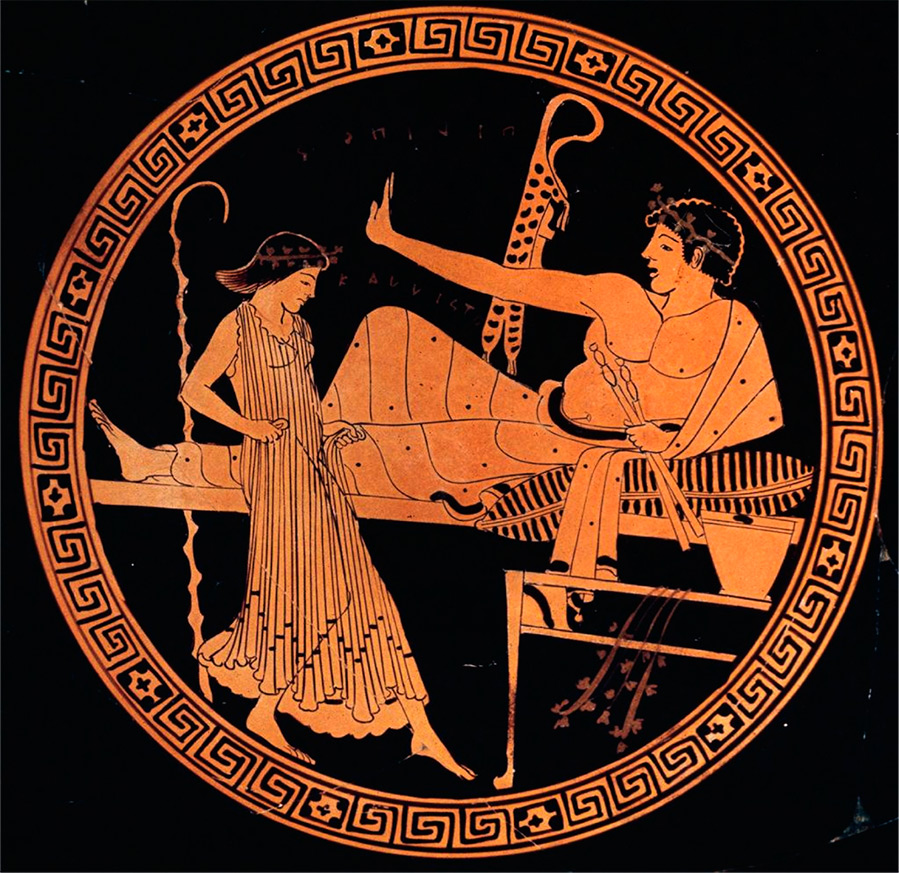
Red-figure kylix depicting a symposium of Ancient Greece. 490–480 BC e.
The girl is dressed in a chiton
Jewelry in Ancient Greece, unlike Ancient Egypt, was worn only by women. The only jewelry that men could wear were rings. Also, it was the Greek women who were the first to actively use cosmetics for decoration, and not in connection with religious beliefs, as was the case in Ancient Egypt. And the word cosmetics itself Greek origin. Both the word cosmetics and the word cosmos are ancient Greek and have a common meaning - order.
Greek women blushed their cheeks and painted their lips, used aromatic oils, but the most important rule of makeup remained the rule of the golden mean. The ancient Greeks believed that in everything, including jewelry and makeup, one must adhere to the rule of the golden mean and try only to complement natural beauty.
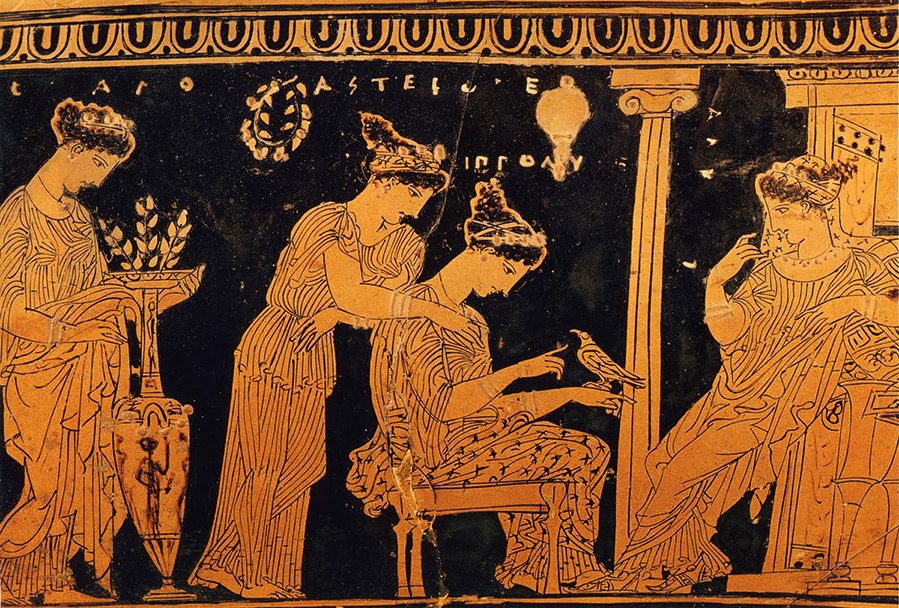
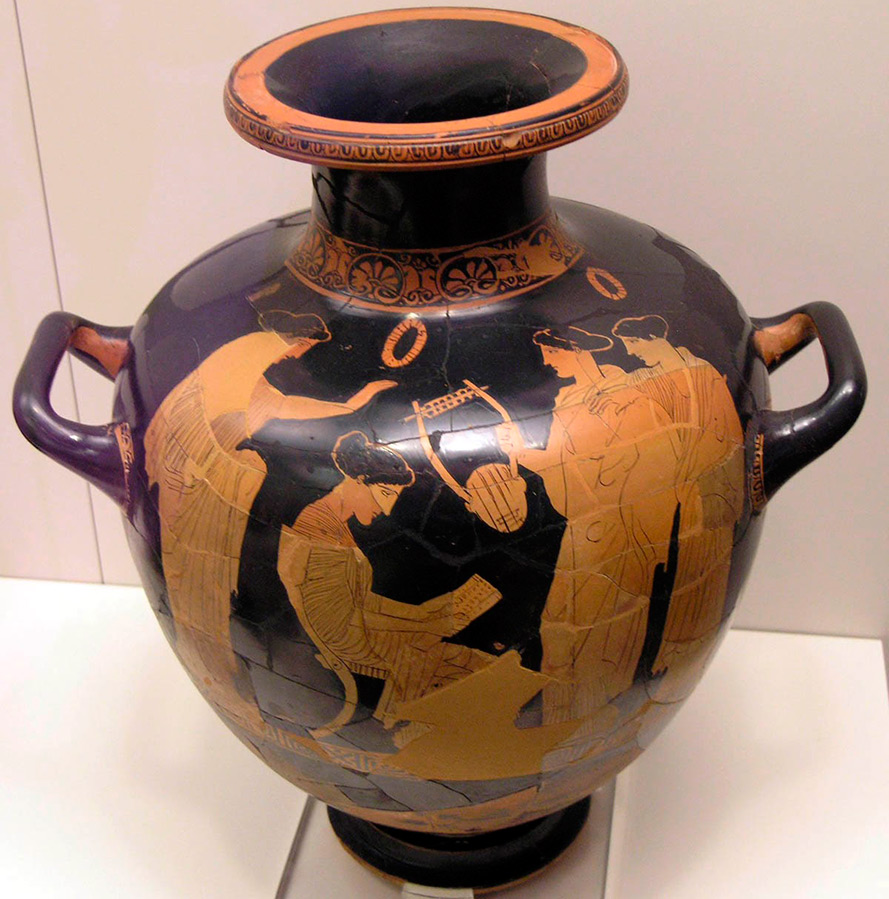
In addition to ancient Greek clothing, there is also ancient Roman clothing. And to the untrained eye, this is the same thing, and it looks something like a man in a sheet. So it’s worth figuring out how to diversify this image and what these robes are called. At least to flaunt the terms in conversation.
It is difficult to imagine that all guests will come to the holiday in Greek costumes. Men will probably feel uncomfortable without their pants on, so to speak. Therefore, it is enough that the guests’ clothing will have a hint of Greek style. There are plenty of such wardrobe items in stores, and even in your own closets. You just need to look at this style with fresh eyes.

Summer tunics and shirts with a pattern related to the theme.
If you make a suit yourself, and do not follow the beaten industrial path, you should remember that the Greeks did not sew or cut clothes.
Homer's description of Hera's clothing.
She dressed herself in that fragrant robe, like Athena,
Having woven it, she decorated it with many wondrous patterns,
She fastened the robe with golden clasps above her breasts,
She girded her waist with a belt, fringed with darkness,
I put beautiful earrings with triple pendants in my ears,
Those who played brightly: the goddess shone with charm all around.
The sovereign Hera overshadowed her head with a light cover,
Lush, new, which, like the sun, shone with whiteness.
If anyone still has doubts about color range, then the conservative way of looking at it is: white and ivory. But this is a modern misconception about the style of the ancient Greeks, inspired to us marble statues those times. Meanwhile, archaeologists have already proven that the Greeks not only wore colorful clothes, but also painted patterns on them, and also painted statues. But I recommend treating patterns on fabrics with great caution; it’s easier to choose plain fabrics of different colors.
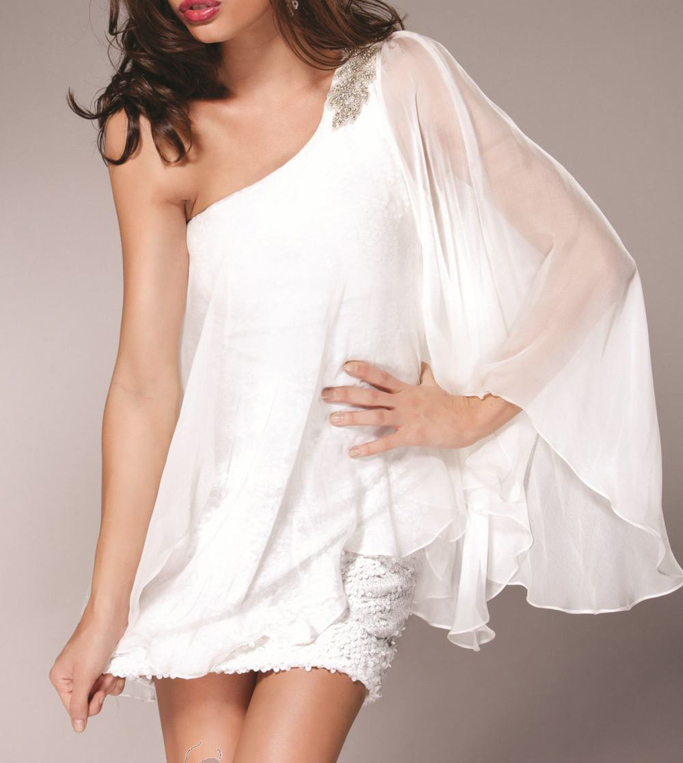

The clothing of the ancient Greeks was very simple in design, it consisted of rectangular pieces of fabric of various lengths and widths, draped over the figure different ways. The composition of Greek fabrics is wool or linen. But we can choose any fabric we like, and a nice bonus is that after the party we can take the outfit apart and sew something else out of it.
Single-color fabrics can be decorated with embroidered borders and appliqués. The pattern is a stylized geometric or floral ornament. This is a meander, a Cretan wave, a palmette. The ornament is applied horizontally. And in combination with vertical lines drapery, this makes the folds especially expressive, emphasizing the beauty and plasticity of movements.
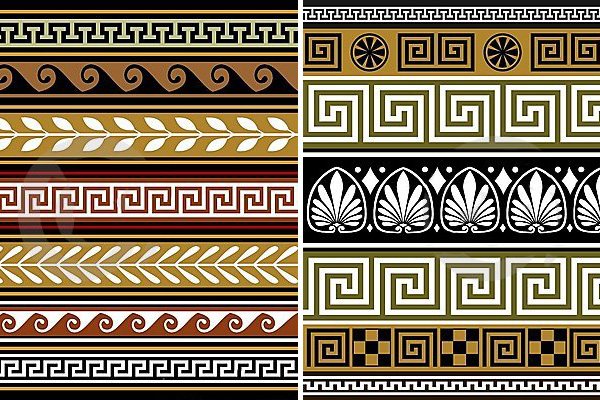
Meander - ornament options
I made my costume from a piece of silk fabric lying around on one of the mezzanines. Having tried several options from the Internet on how to attach it to myself, I came to the conclusion that either the piece is too small for it to fit as it should, or it will not fit according to those diagrams. On one side there were folds on the thigh that were not there on the other side, since there was a cut on that side and the fabric lay without folds.
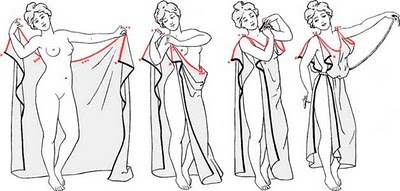
So I cut the fabric into two unequal pieces. The larger one is on the back, gathered in folds in the area of the shoulder straps, and the smaller one is in the front, respectively, with fewer folds. On the shoulders, the fabric is secured not only with decorative ties, but also sewn with thread, since silk is a slippery material and the knots could come undone. The waist can be anything, because if you look at the pictures, there were high, regular, and low options. In Greece, this mattered: maidens wore low belts, and married ladies wore high waists.
“In the morning some drew the ships to the sacred sea,
They were loaded with wealth and wives, girded low.”
(Odyssey, Homer)
This implies that they took unmarried women.
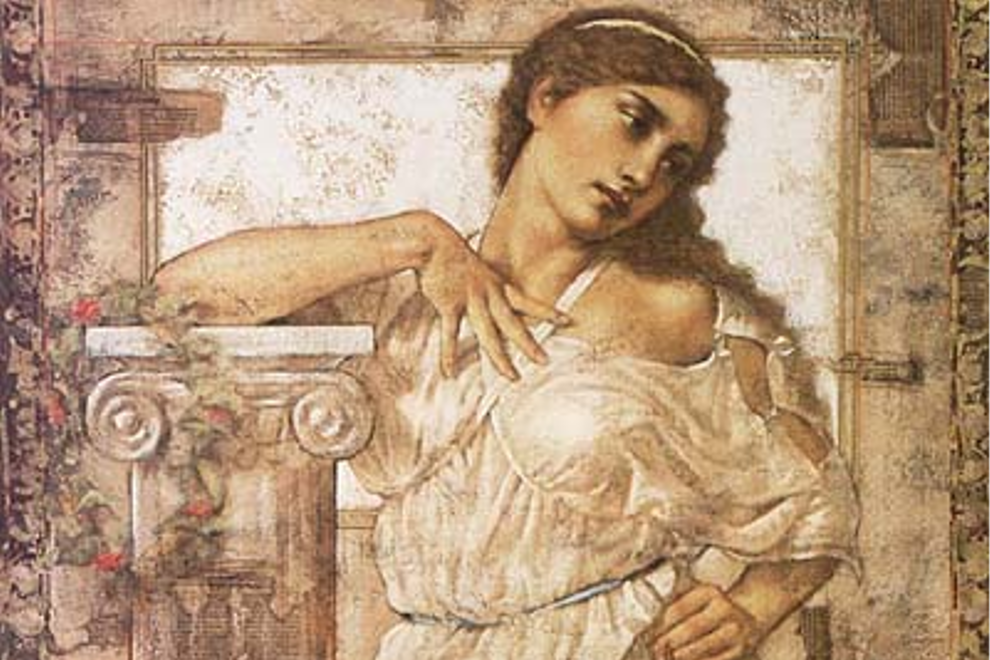
Due to the fact that I chose the oversized option, there was a possibility that the dress would open up excessively, since the fabric at the waistband did not hold anything together. The Greeks could pin the edges of the fabric with their pins, but not sew them together. I chose the opening option that was acceptable to me and simply sewed up the edges, with the seam inward, which disguises itself as a fold.

My version is quite simple, so you can make the costume more complicated if you wish. By the way, not everyone has to be Greek. During the times of Ancient Greece, there were other peoples and they carried on trade, so it can be assumed that an Egyptian or an Arab or someone else might be at such a holiday... The main thing is to understand that this masquerade is not needed to create historical authenticity, but to have fun and therefore everything perhaps it would be good and fun for everyone.
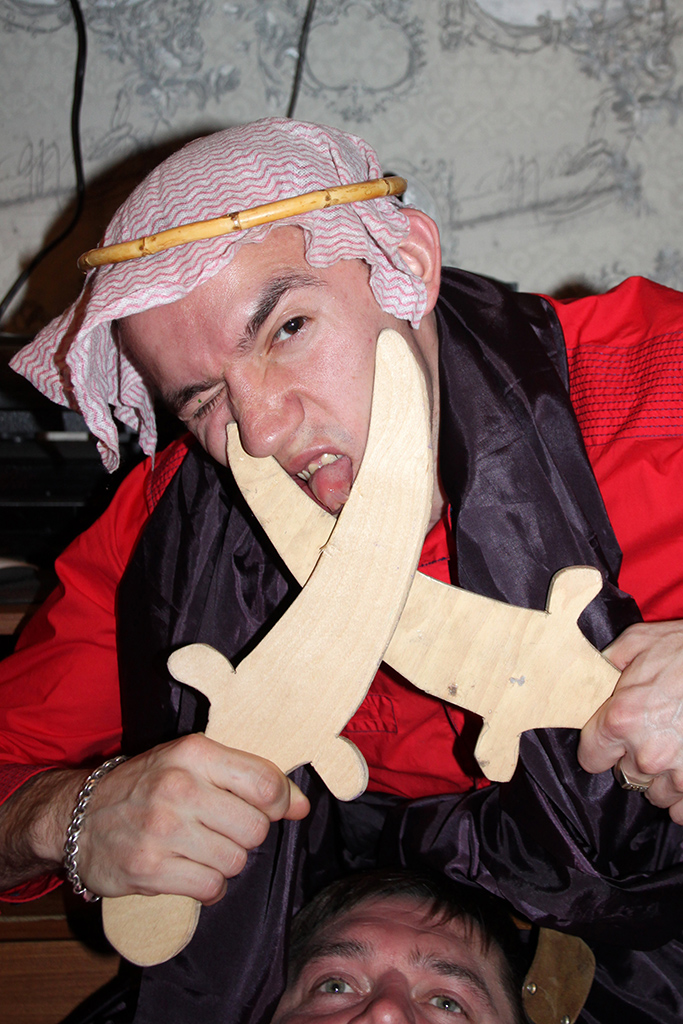

The funniest thing that the ancient Greek clothing style allows you to do is wrap everyone in sheets already in the process of celebrating. To do this, you need to select suitable sheets and tablecloths from the ones available in the house, and you can also add suitable pieces of fabric, finished along the edges. Moreover, these pieces do not have to be the size of a sheet; they can be relatively small, and they can be tied over one shoulder. Find ribbons or belts for this fabric, as well as pins or suitable brooches. As well as any unrelated items, but which can be used when fun.
![]()
More details about variants and traditional historical names about men's clothing in Ancient Greece.
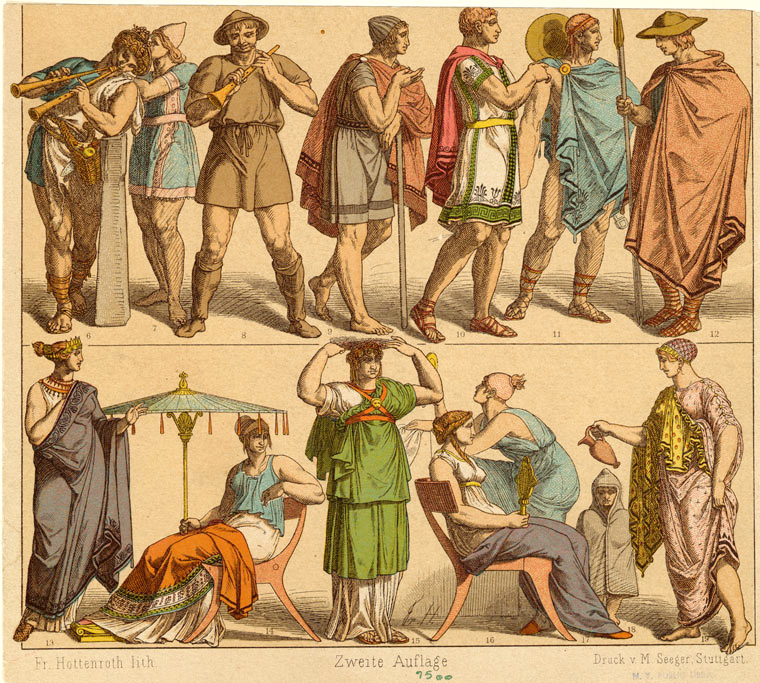
A chiton was made from a rectangular piece of material about a meter long or from two identical, but much larger pieces of material. The tunic on the shoulders was fastened with buckles called fibules. The tunic could be sewn at the side or left open on one side; the right shoulder was sometimes left bare. Sometimes chitons were made with small sleeves. The tunic was girded with a belt, an overlap was made from the excess length, and the width was evenly distributed with folds. The length of the chiton could vary, but most often reached the knees. In the classical period, the long tunic was ritual clothing. It was worn by priests and actors on stage. From the long, gathered chiton originates the double chiton - diploidon.
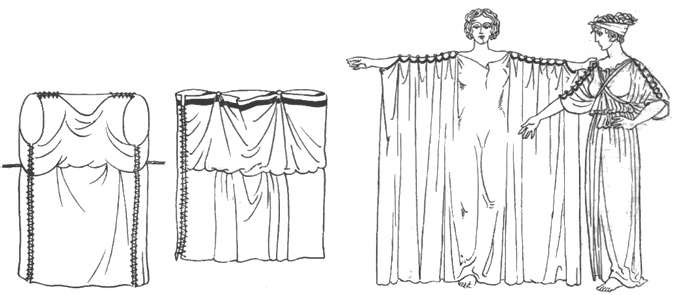
The luxurious outer cloak is faros, the more modest one is chlaina. Pharos was worn by the aristocracy. It was made of expensive Egyptian linen, a real beautiful purple color. A longer cloak with more folds was called a himation. This is a rectangular piece of woolen fabric measuring 1.7 (4 m), draped around the figure in various ways. To prevent the fabric from slipping, a weight - pieces of lead - was sewn at the back. Men put on the himation as follows: one end, slightly draped or folded, was lowered from the left shoulders on the chest, the remaining fabric was placed on the back and passed under the right arm, leaving the hand free, and, having laid the fabric in beautiful folds, it was thrown over the left shoulder to the back. Sometimes the himation was thrown from the back to the right shoulder, covering the right arm or both arms. The wider and longer himation was called pallium.
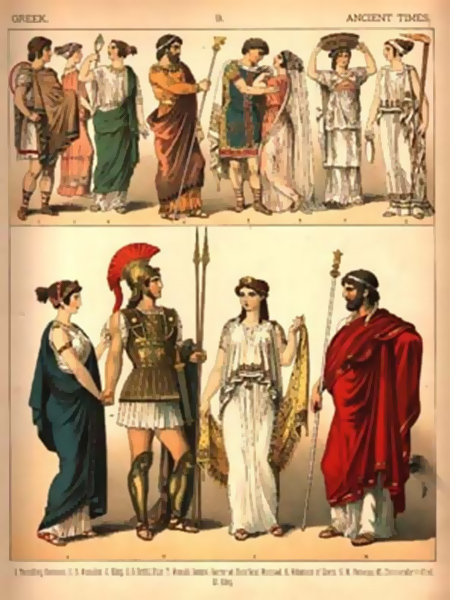
Chlamys, a smaller version of the himation with dimensions of approximately 1/2 m. This is clothing primarily for horsemen, soldiers, youths and travelers. It was fastened with a buckle - a fibula on the right shoulder or left shoulder, and the free ends fell in beautiful tails, leaving one hand open. Chlamis was usually made of thick woolen fabric. The doubled himation or chlamys was called diplax. The Spartans most often did not wear a chiton, but were content with only a himation made of natural-colored wool.
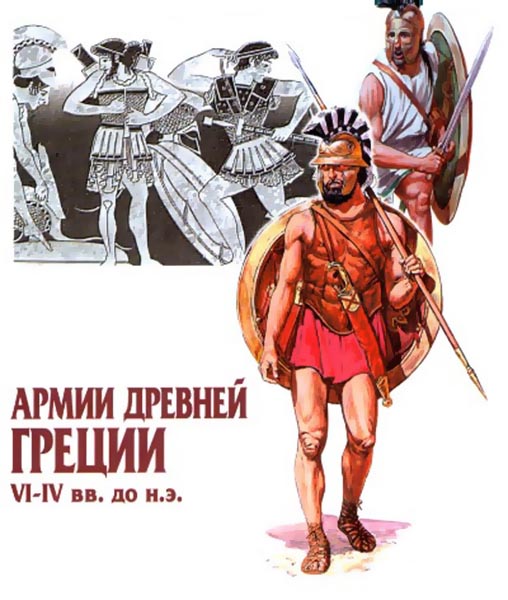
If you have the opportunity and desire, you can try yourself in the role Greek warrior in armor. The warriors' underwear was a short chiton, under which a metal belly was reinforced. A shell was put on over the chiton. Most warriors had metal armor, in the Homeric period - from copper, and later - from copper alloys. The Greeks also knew cuirasses made of thick glued canvas or leather with metal parts sewn on them. To make metal shells more flexible, they were made from individual parts, fastened with hinges or hinges.
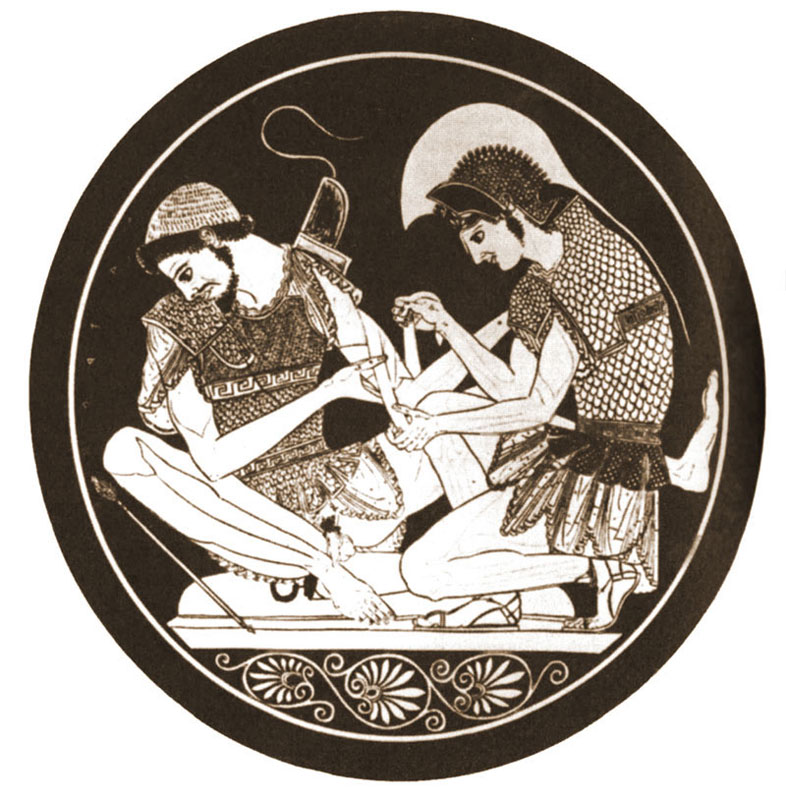
The warriors covered their heads with a helmet, and the shape and decoration of the helmets changed over time. The most ancient helmets were simple, then a crest appeared on them, crowned with a horse tail or feathers; the embossing on the helmets consisted of geometric and floral ornament, especially rich ones were decorated with scenes from mythology or military exploits. The most vulnerable parts of the legs - the shins - were covered with knemides leggings. Made to the shape of a leg, they were fastened with straps and buckles and were usually decorated with hammered patterns. The outer clothing of warriors was chlamis. Generals and military leaders wore chlamis dyed purple.
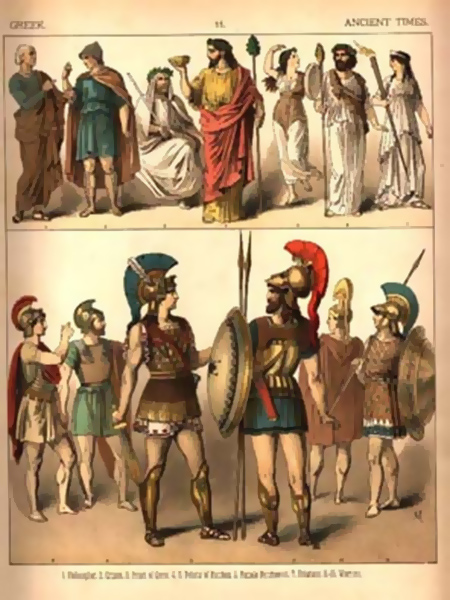
Villagers and slaves mostly wore a short, free-flowing tunic made of wool with one strap over the right shoulder, the so-called exomis. During hard work, slaves were content with one loincloth.
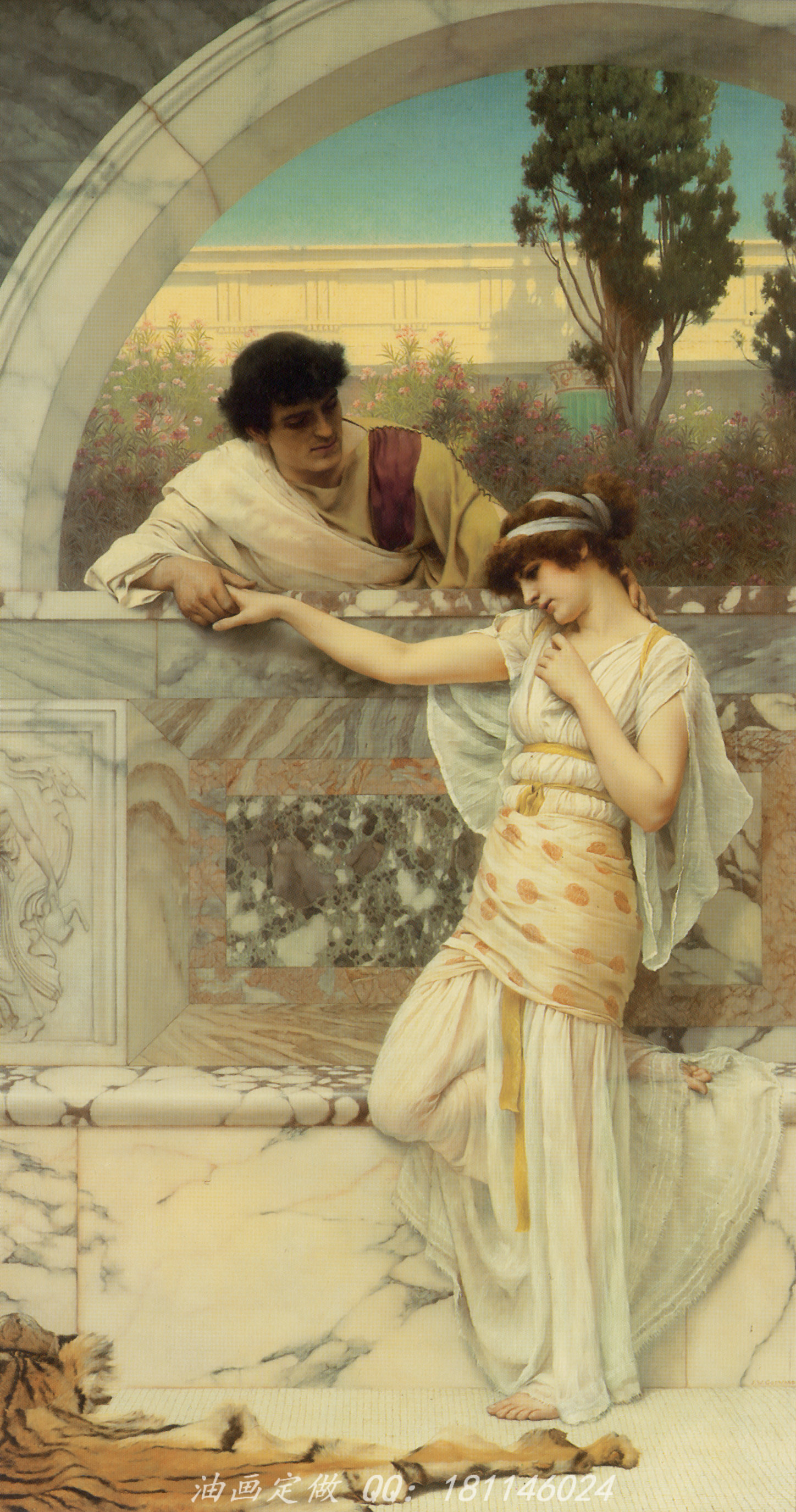
"Yes or no?" John William Godward
Women's clothing in Ancient Greece was much more varied and colorful than men's.
A chiton with a lapel is a diploid, a wide chiton with clasps along the arms: a rectangular piece of fabric is 60-70 cm larger than human height. Its upper edge was bent back by 50-60 cm, then fastened with buckles - brooches on the shoulders, slightly draping the front part. At the fastening points, the lapel was draped with several folds. The chiton was girded with a belt, distributing its entire width in even soft folds around the figure or only in the center of the front and back. The excess length formed a kind of overlap over the belt - kolpos. Often the kolpos was fastened on top with another belt. Sometimes the chiton was made from two pieces of unequal length, the piece for the back was much longer, then the excess fabric served as a cover for the head.
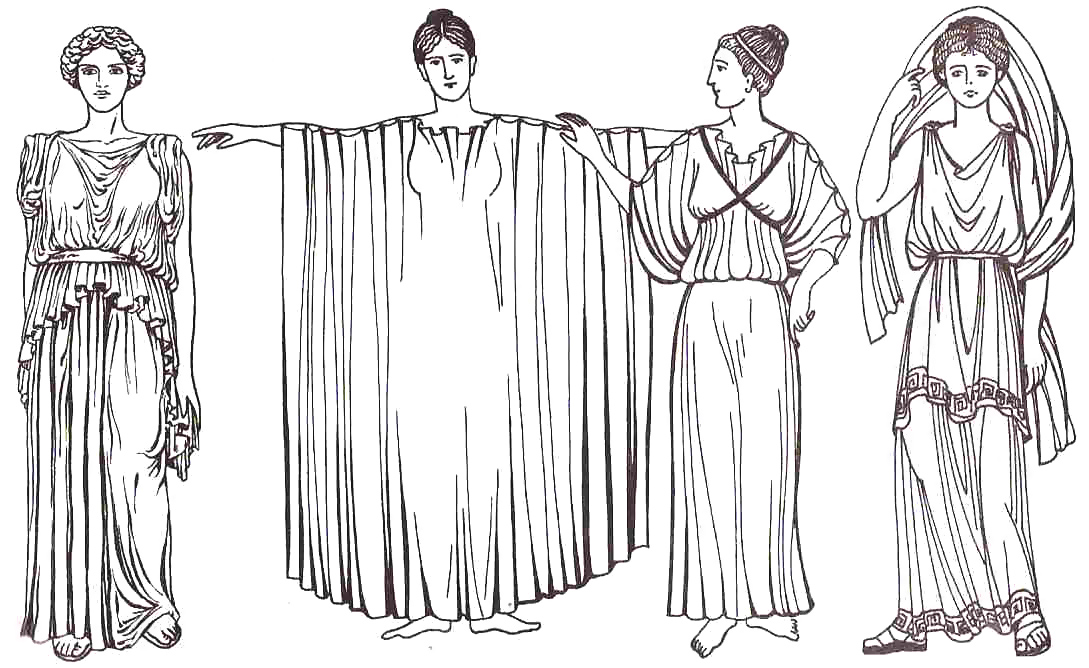
The diploidium (the lapel of the chiton) was often trimmed with embroidery, and in the Hellenistic era it was made from fabric of a different color. The length of the diploid could be different: up to the chest, hips, knees. The ratio of diploidia, kolpos and the lower part of the chiton can create excellent proportions, giving a slim figure.
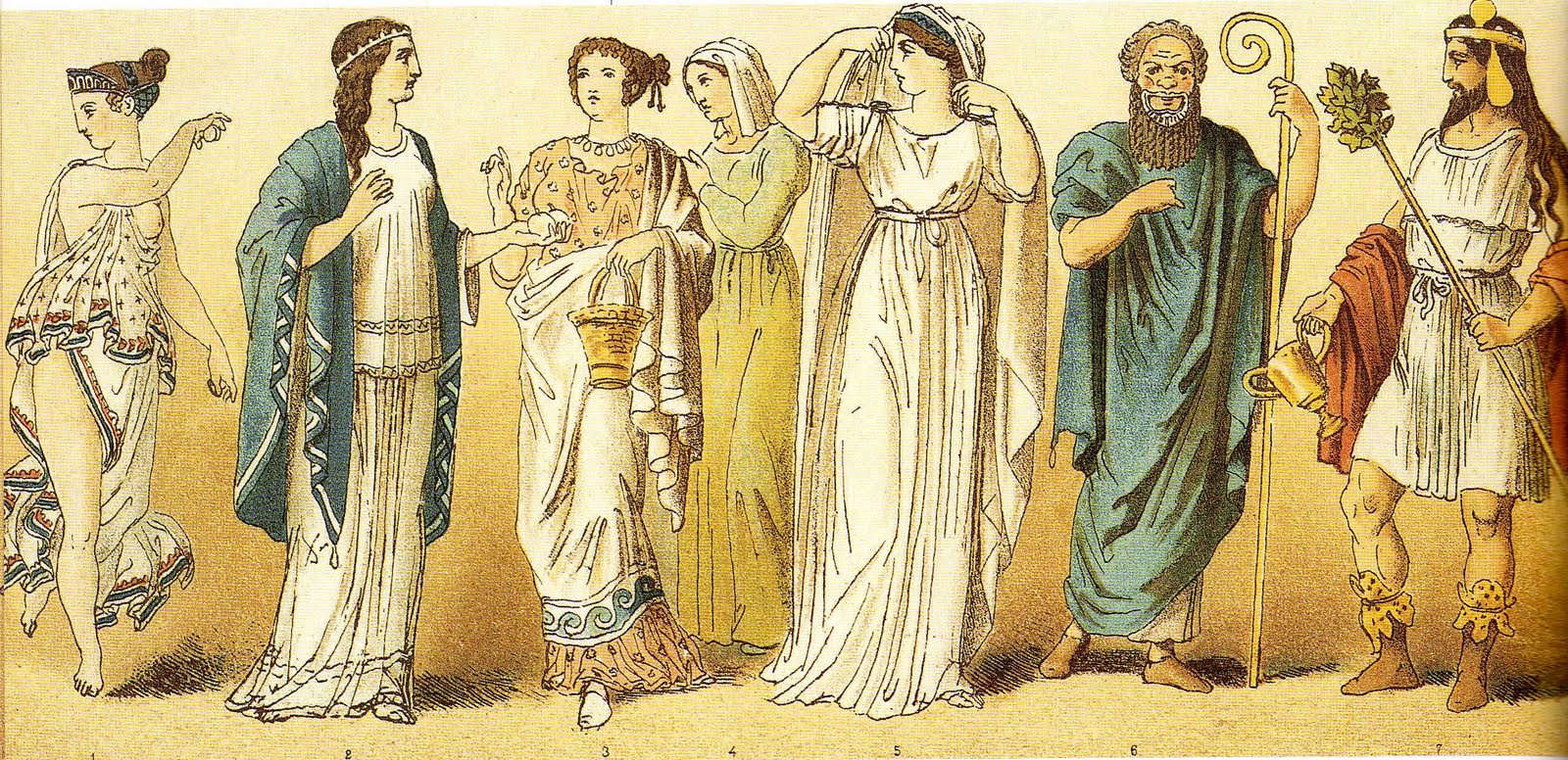
Ionic chiton, without fasteners along the arms: the fabrics are soft, rather thin, and have been specially corrugated. The entire width of the tunic was grabbed with a belt and a kolpos was made. The later Ionic chiton, made of very thin soft fabric, was richly draped and girded around the waist, hips and crosswise on the chest. Thanks to its large width, some semblance of sleeves was created.
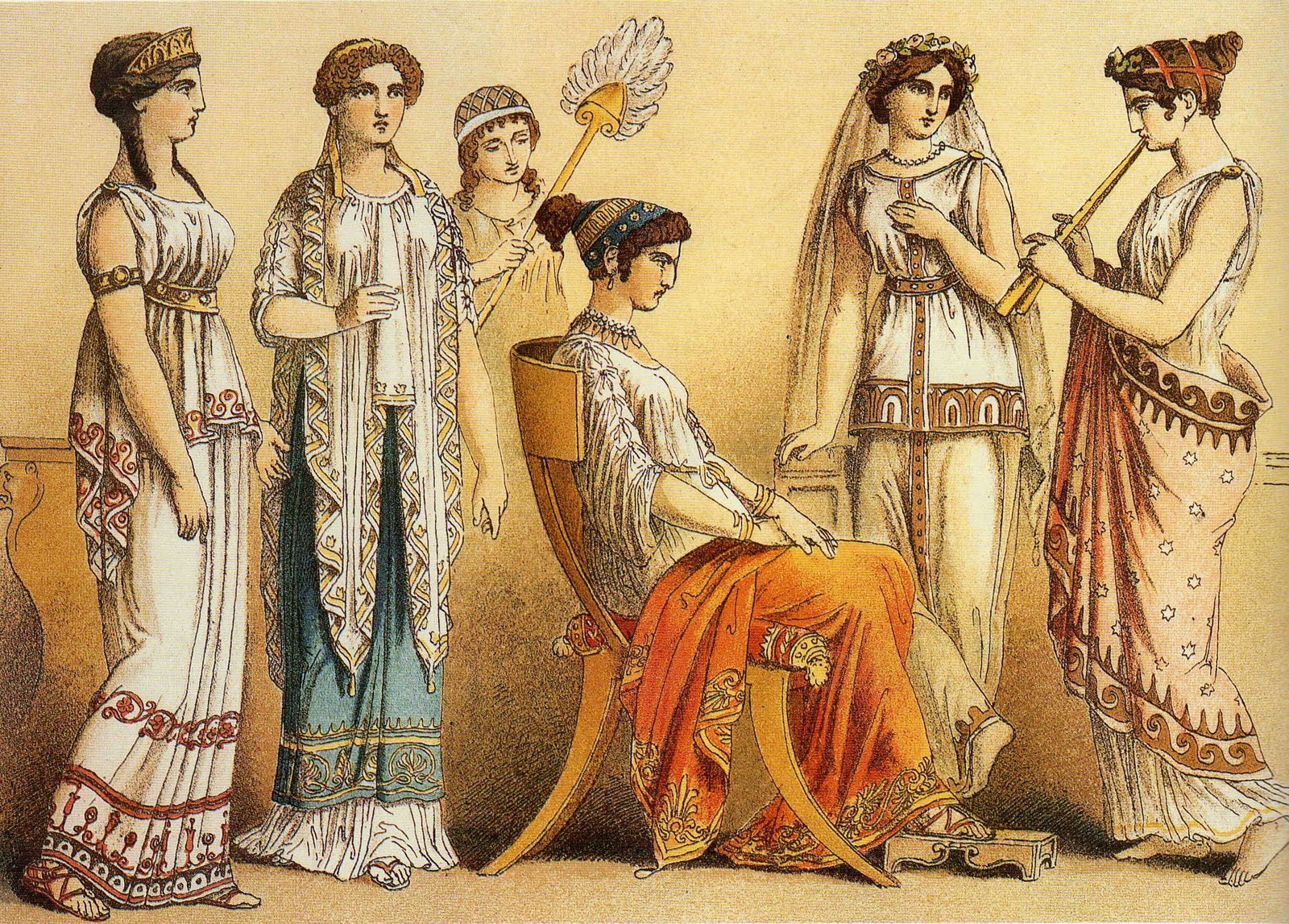
The female himation was smaller than the male one, but much more richly ornamented. Without a himation, a Greek woman usually did not appear on the street.
Spartan girls wore tunics that were not sewn on the right side, while the unstitched edges of the fabric were trimmed with a border and draped. This tunic was called peplos. Athena was usually depicted wearing peplos. On the statues of Athena, there are images of two clothes at the same time - an Ionic chiton made of soft and rather thin fabric and a peplos made of dense, falling in heavy folds, belted over the diploid with a second belt.
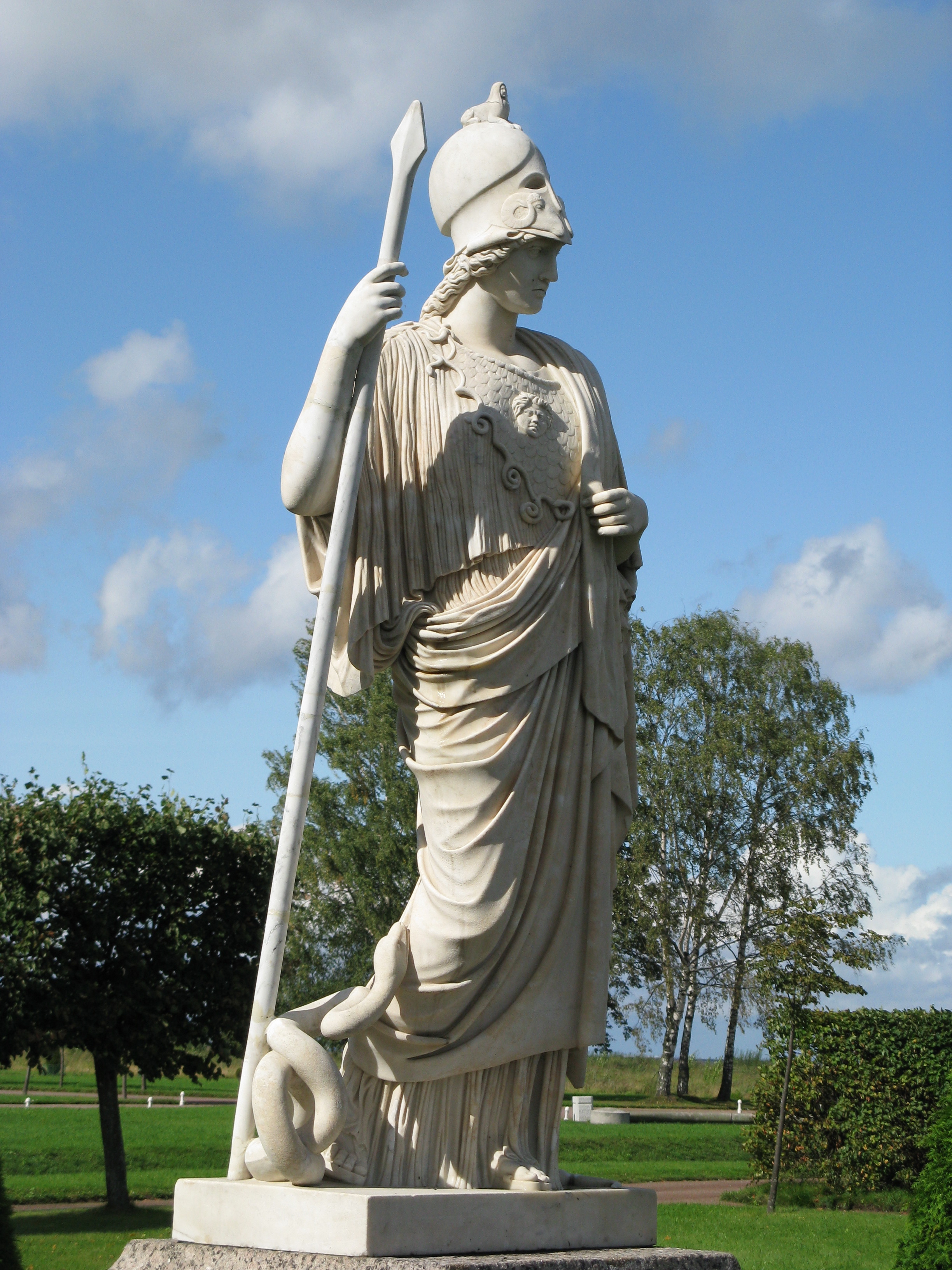
Greek woman’s costume: “Nannion covered the thinnest Ionian chiton with a blue, gold-embroidered himation with the usual border of hook-shaped stylized waves along the lower edge. In oriental fashion, the hetaera's chemation was thrown over her right shoulder and secured over her back with a buckle on her left side. Thais was dressed in a pink, transparent chiton, brought from Persia or India, gathered in soft folds and pinned at the shoulders with five silver pins. Gray himation with a border of gray daffodils enveloped her from the shoulder to the ankles of her small feet, dressed in sandals with narrow silvered straps.” Ivan Efremov “Tais of Athens”.
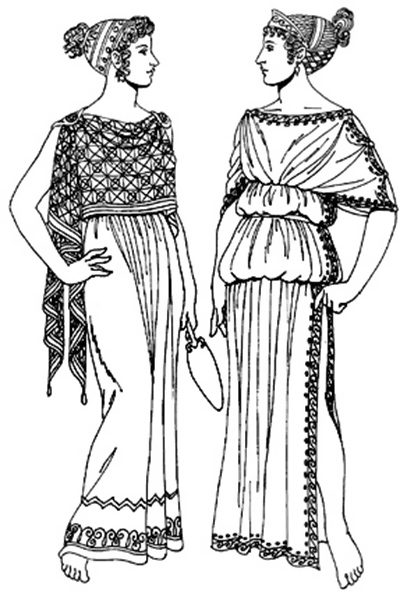
Hats and hairstyles
The Greeks wore hats mainly in bad weather or while traveling. Round Felt hat with wide brims and a low crown - petasos - the most common headdress. It was also worn on a strap, thrown over the shoulders. Hermes was depicted wearing such a hat, but with small wings. Another type of headdress was pilos - a kind of cap made of leather, straw or fur for protection from the sun and bad weather.
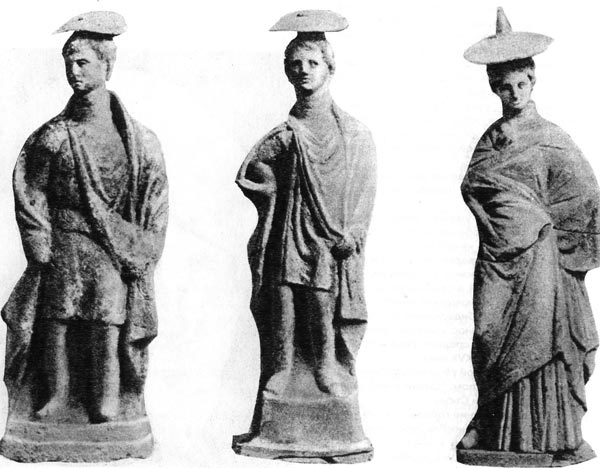
During the classical period, men wore short hair, round beard and mustache. The young men shaved their faces and had long, curled locks held in place by a metal hoop called fillet. The Greeks considered a beard to be a man's dignity. Sculptors depicted great people with a youthful face, and emphasized their age with a beard.
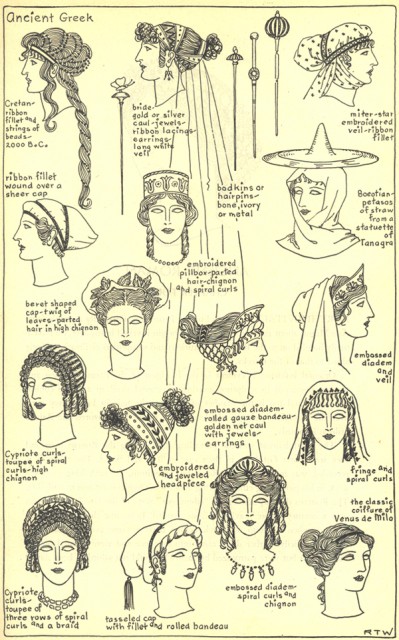
Greek women rarely wore hats, covering themselves in bad weather with the upper edge of the himation. Tanagra figurines depict girls in round straw hats– foils that protect your face from sunburn.
Abundant, lush, long hair were one of the first signs female beauty in Ancient Greece. They were combed in the most complex ways and secured on the head with large headpins or headbands and hoops. various shapes(diadem). The Greeks invented not only fake braids, but even wigs.
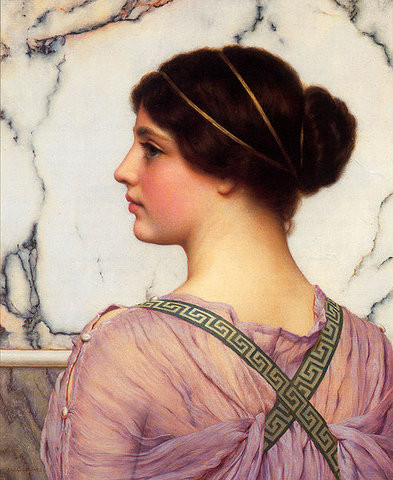
Initially loosely curled, falling over the shoulders, hair began to be styled in complex knots and braids, placed around the head and secured with ribbons, wreaths, hairpins and combs. The Greek knot has survived to this day. This is hair combed in the middle, curled in waves, low on the forehead and along the cheeks, raised at the back and tied in a knot at the back of the head. Hair decorations also included nets of gilded cords, combs, halos (nimbus) - cotton hair ribbons embroidered with gold.
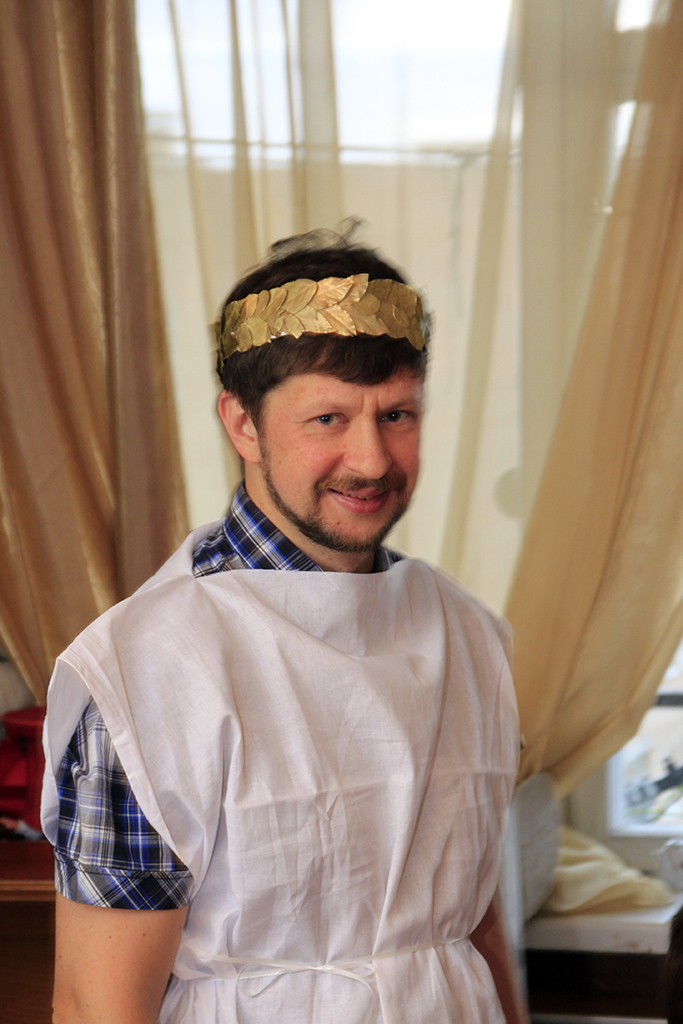
Separate topic: laurel wreaths. Above in the photographs in this article there are two types: one with laurel leaves glued to a cardboard hoop, the second woven from laurel branches that were bought at the market in the form of a laurel broom. Wreaths can be used as accessories, or they can be used to honor winners in any competitions.
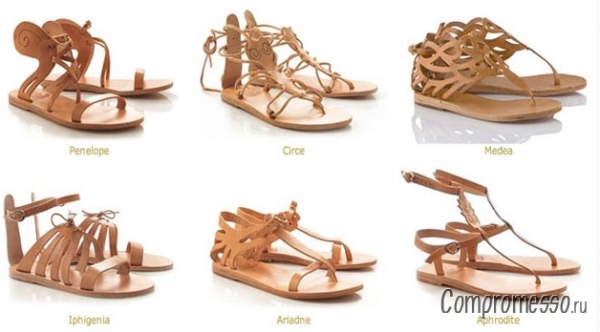
It was customary for the Greeks to walk barefoot in their homes; shoes were worn only on the street. Greek women preferred sandals, which were thick leather soles with straps attached to them that were woven around the feet quite high. In Greek images there are many transitional variations from sandals to high laced boots, sometimes with rich decorations in the upper part and holes punched in it. They were often made of colored leather, richly decorated with embroidery and even metal plaques. Decorative value sandals in a suit were enhanced by the use of colored, gilded leather, decorated with metal plaques and embroidered with pearls.
The most simple form- carbate, the most common type of antique shoes. It was a piece of cowhide, cut into the shape of a sole, which was attached to the ankle with laces passed through holes in the leather outsole. In Greece, shoes with thick cork soles - kothornos - were popular. Since the time of Aeschylus, it has been worn by actors in Greek tragedies to appear taller on stage.



